David Simon's Blog, page 7
October 29, 2018
A Dig at Zippori
During my two month visit to Israel, I participated in four archaeological digs, at Gezer, Tel Hadid, Zippori and at Tel Dan. My favorite experience was the work at Zippori.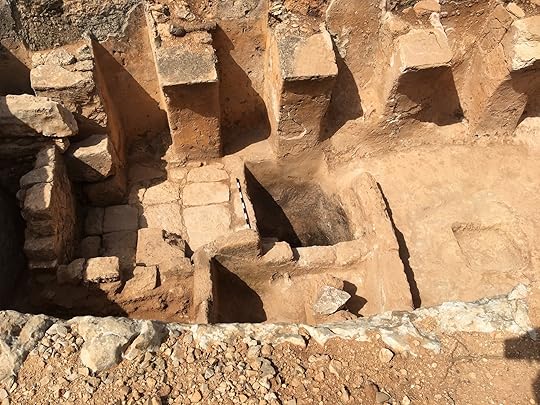 Arches Reservoir at ZipporiZippori was the capital city of Galilee in the first century AD. It is located a few miles from Nazareth, and many feel that Joseph the father of Jesus worked on government projects at Zippori.
Arches Reservoir at ZipporiZippori was the capital city of Galilee in the first century AD. It is located a few miles from Nazareth, and many feel that Joseph the father of Jesus worked on government projects at Zippori.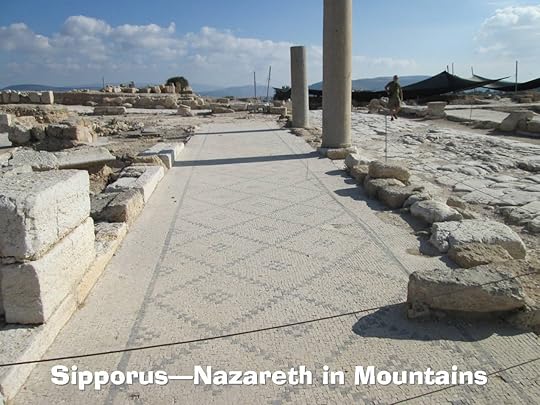 Merchants sidewalk along main streetThe cardo of this city is amazing. It is actually two roads that cross each other at the main intersection. Buildings have been recovered along both roads.
Merchants sidewalk along main streetThe cardo of this city is amazing. It is actually two roads that cross each other at the main intersection. Buildings have been recovered along both roads.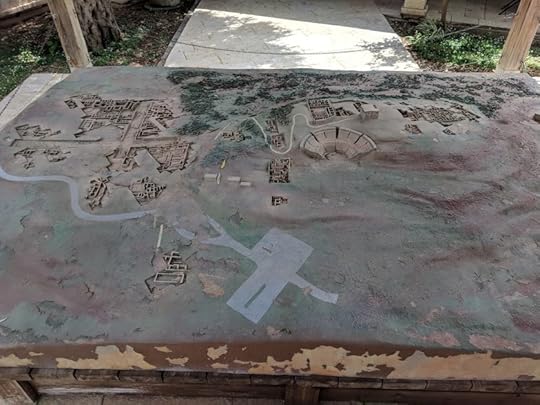 Site map of ZipporiThe city also contains amazing mosaics. Some are located in what is called the Nile house.
Site map of ZipporiThe city also contains amazing mosaics. Some are located in what is called the Nile house.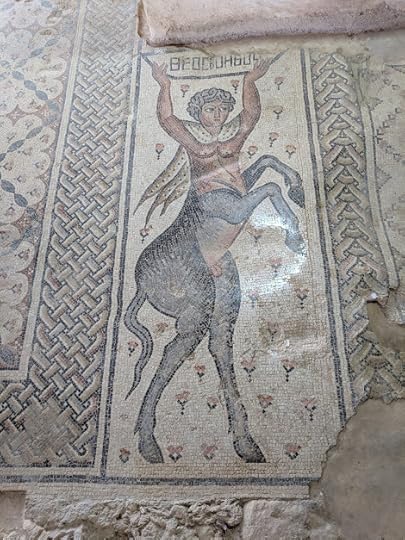 Centar at the Nile HouseOther mosaics can be found at the Dionysus House.
Centar at the Nile HouseOther mosaics can be found at the Dionysus House.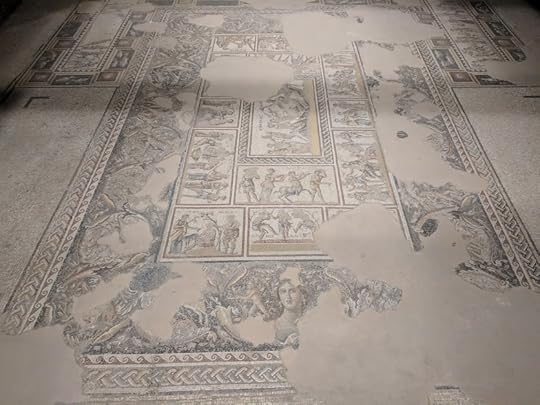 Mona Lisa of GalileeThere is also an amazing mosaic in the Synagogue.
Mona Lisa of GalileeThere is also an amazing mosaic in the Synagogue.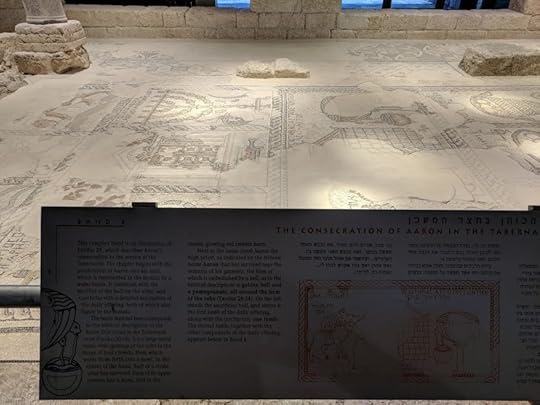 Mosaic on the floor of the SynagogueWe worked at the first century water project. This is a cistern that held water that flowed down hill from spring along the Nazareth ridge.
Mosaic on the floor of the SynagogueWe worked at the first century water project. This is a cistern that held water that flowed down hill from spring along the Nazareth ridge.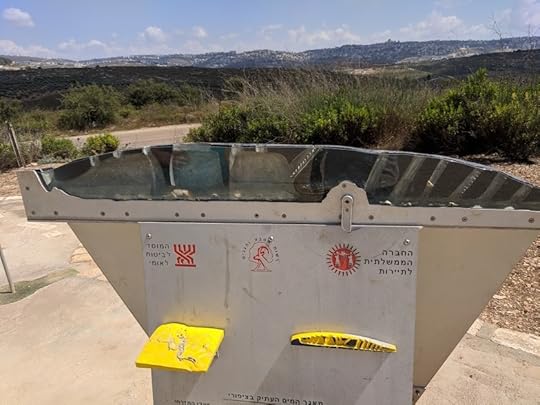 Nazareth Ridge above ZipporiThere are actually two cisterns. The first was untouched since the first century.
Nazareth Ridge above ZipporiThere are actually two cisterns. The first was untouched since the first century.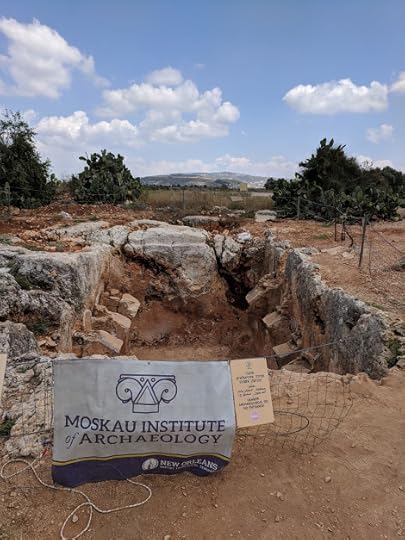 Arches Reservoir at ZipporiThe second was developed into a wine press.
Arches Reservoir at ZipporiThe second was developed into a wine press.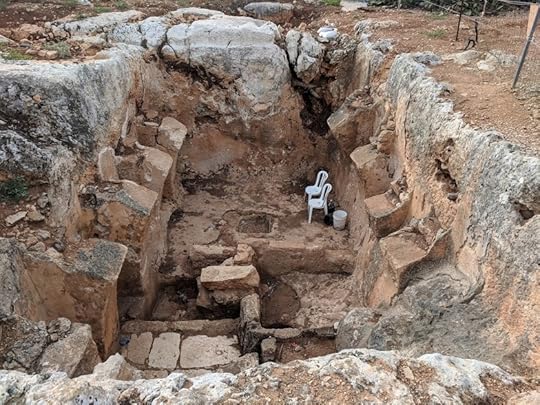 First view of the Arches ReservoirWine was stomped at one end of the cistern
First view of the Arches ReservoirWine was stomped at one end of the cistern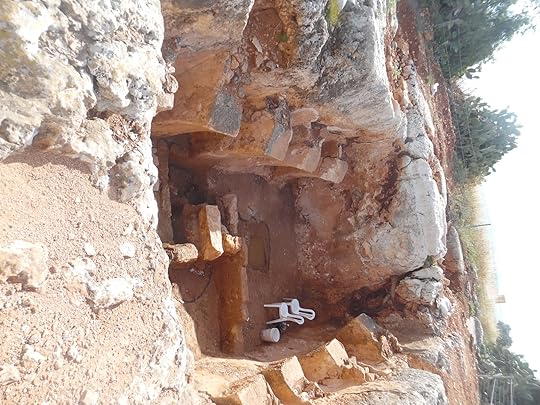 First view of the Arches ReservoirIt flowed into a mikvah that was more than seven feet deep.
First view of the Arches ReservoirIt flowed into a mikvah that was more than seven feet deep.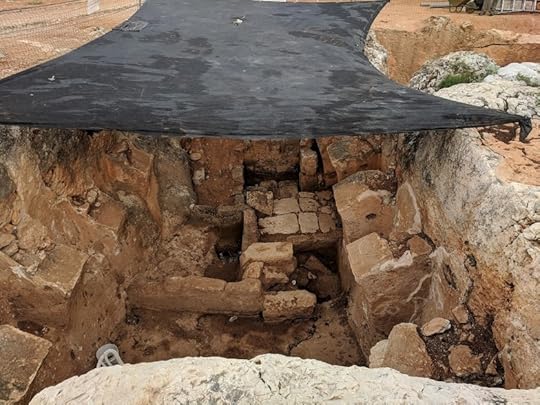 Shade tarp over the Arches ReservoirThere was also a stone reception area with pavers.
Shade tarp over the Arches ReservoirThere was also a stone reception area with pavers.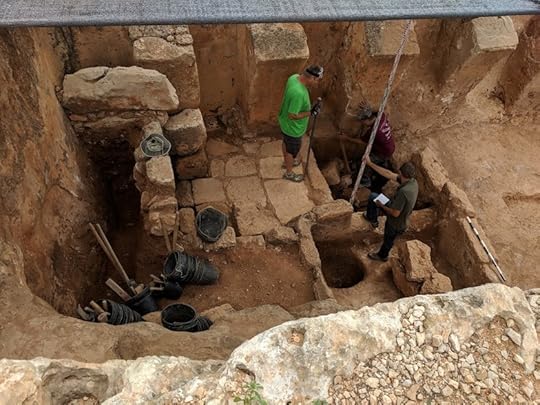 Measuring the MikvahWe helped excavate the mikvah area.
Measuring the MikvahWe helped excavate the mikvah area.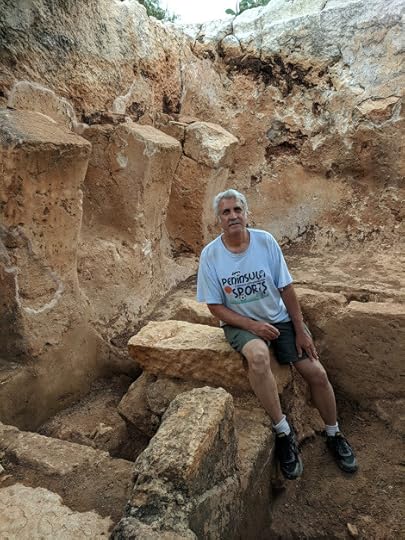 Debris and stones above the MikvahIt started by clearing roofing members which fell. The roof was a system of arches and coverings to keep the water in the dark until it was needed.
Debris and stones above the MikvahIt started by clearing roofing members which fell. The roof was a system of arches and coverings to keep the water in the dark until it was needed.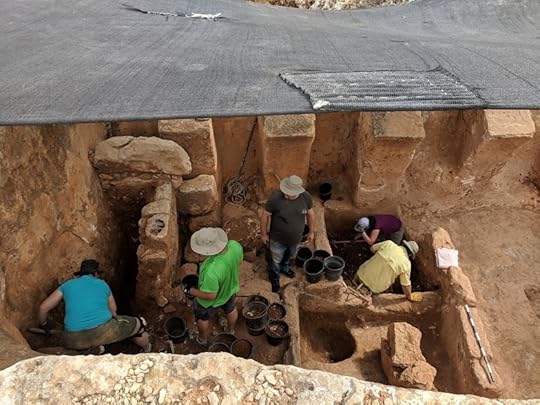 Digging Team at ZipporiWe hauled lots of dirt out of the system, and also rocks. We found coins, pottery and other items as we dug.
Digging Team at ZipporiWe hauled lots of dirt out of the system, and also rocks. We found coins, pottery and other items as we dug.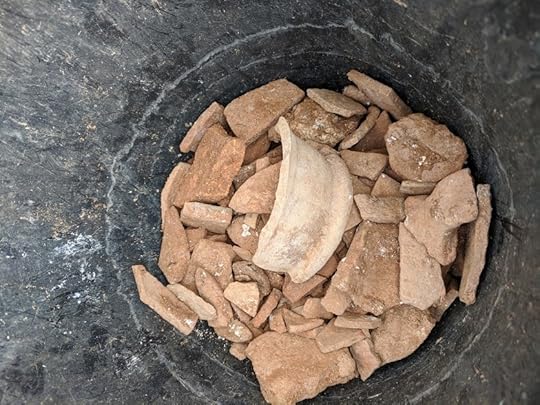 Pottery found during our dig at ZipporiWe worked with several archeologists who taught us about the site. They showed us the difference between first and second century plaster, as well as showing us areas of the cistern (structure) that was not plastered.
Pottery found during our dig at ZipporiWe worked with several archeologists who taught us about the site. They showed us the difference between first and second century plaster, as well as showing us areas of the cistern (structure) that was not plastered.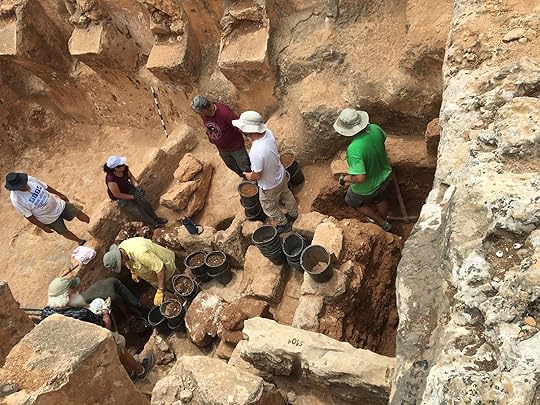 Filling dirt buckets at ZipporiI have included some stories from the hills of Galilee in my new book, Israel:Stories for Your Journey.
Filling dirt buckets at ZipporiI have included some stories from the hills of Galilee in my new book, Israel:Stories for Your Journey.
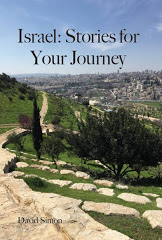 New book on IsraelSome of the places I visited during the two weeks of my tour were places I visited before, but since I helped plan the tour, there were some new places also.
New book on IsraelSome of the places I visited during the two weeks of my tour were places I visited before, but since I helped plan the tour, there were some new places also.
 Arches Reservoir at ZipporiZippori was the capital city of Galilee in the first century AD. It is located a few miles from Nazareth, and many feel that Joseph the father of Jesus worked on government projects at Zippori.
Arches Reservoir at ZipporiZippori was the capital city of Galilee in the first century AD. It is located a few miles from Nazareth, and many feel that Joseph the father of Jesus worked on government projects at Zippori. Merchants sidewalk along main streetThe cardo of this city is amazing. It is actually two roads that cross each other at the main intersection. Buildings have been recovered along both roads.
Merchants sidewalk along main streetThe cardo of this city is amazing. It is actually two roads that cross each other at the main intersection. Buildings have been recovered along both roads. Site map of ZipporiThe city also contains amazing mosaics. Some are located in what is called the Nile house.
Site map of ZipporiThe city also contains amazing mosaics. Some are located in what is called the Nile house. Centar at the Nile HouseOther mosaics can be found at the Dionysus House.
Centar at the Nile HouseOther mosaics can be found at the Dionysus House. Mona Lisa of GalileeThere is also an amazing mosaic in the Synagogue.
Mona Lisa of GalileeThere is also an amazing mosaic in the Synagogue. Mosaic on the floor of the SynagogueWe worked at the first century water project. This is a cistern that held water that flowed down hill from spring along the Nazareth ridge.
Mosaic on the floor of the SynagogueWe worked at the first century water project. This is a cistern that held water that flowed down hill from spring along the Nazareth ridge. Nazareth Ridge above ZipporiThere are actually two cisterns. The first was untouched since the first century.
Nazareth Ridge above ZipporiThere are actually two cisterns. The first was untouched since the first century. Arches Reservoir at ZipporiThe second was developed into a wine press.
Arches Reservoir at ZipporiThe second was developed into a wine press. First view of the Arches ReservoirWine was stomped at one end of the cistern
First view of the Arches ReservoirWine was stomped at one end of the cistern First view of the Arches ReservoirIt flowed into a mikvah that was more than seven feet deep.
First view of the Arches ReservoirIt flowed into a mikvah that was more than seven feet deep. Shade tarp over the Arches ReservoirThere was also a stone reception area with pavers.
Shade tarp over the Arches ReservoirThere was also a stone reception area with pavers. Measuring the MikvahWe helped excavate the mikvah area.
Measuring the MikvahWe helped excavate the mikvah area. Debris and stones above the MikvahIt started by clearing roofing members which fell. The roof was a system of arches and coverings to keep the water in the dark until it was needed.
Debris and stones above the MikvahIt started by clearing roofing members which fell. The roof was a system of arches and coverings to keep the water in the dark until it was needed. Digging Team at ZipporiWe hauled lots of dirt out of the system, and also rocks. We found coins, pottery and other items as we dug.
Digging Team at ZipporiWe hauled lots of dirt out of the system, and also rocks. We found coins, pottery and other items as we dug. Pottery found during our dig at ZipporiWe worked with several archeologists who taught us about the site. They showed us the difference between first and second century plaster, as well as showing us areas of the cistern (structure) that was not plastered.
Pottery found during our dig at ZipporiWe worked with several archeologists who taught us about the site. They showed us the difference between first and second century plaster, as well as showing us areas of the cistern (structure) that was not plastered. Filling dirt buckets at ZipporiI have included some stories from the hills of Galilee in my new book, Israel:Stories for Your Journey.
Filling dirt buckets at ZipporiI have included some stories from the hills of Galilee in my new book, Israel:Stories for Your Journey. New book on IsraelSome of the places I visited during the two weeks of my tour were places I visited before, but since I helped plan the tour, there were some new places also.
New book on IsraelSome of the places I visited during the two weeks of my tour were places I visited before, but since I helped plan the tour, there were some new places also.
Published on October 29, 2018 19:54
October 24, 2018
Two Months in Israel
This year I had the privilege of spending two months in the land of Israel. The time was enjoyable and educational. While in the land I participated in a two week tour, four archaeological digs and also wandered various historic sites, shopping areas, recreational parks and various places to eat. 
 Some of the places I visited during the two weeks of my tour were places I visited before, but since I helped plan the tour, there were some new places also.
Some of the places I visited during the two weeks of my tour were places I visited before, but since I helped plan the tour, there were some new places also. 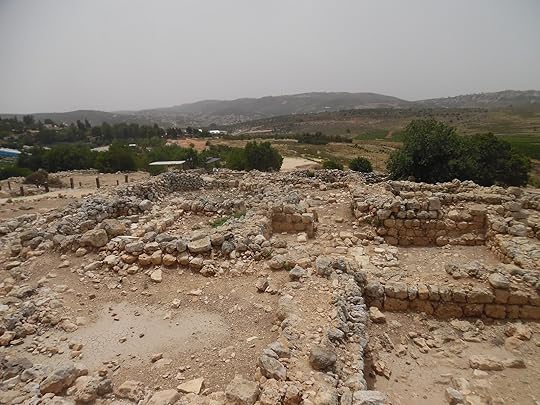 The Archaeological site at ShiloOne of the places I looked forward to seeing was Shilo, the site where Joshua set up the Tabernacle and where young Samuel heard the voice of the Lord. The Tabernacle is long gone, but the hills still stand at this site, the ruins have been made visible and the stories about Israel’s place of worship are still remembered.
The Archaeological site at ShiloOne of the places I looked forward to seeing was Shilo, the site where Joshua set up the Tabernacle and where young Samuel heard the voice of the Lord. The Tabernacle is long gone, but the hills still stand at this site, the ruins have been made visible and the stories about Israel’s place of worship are still remembered.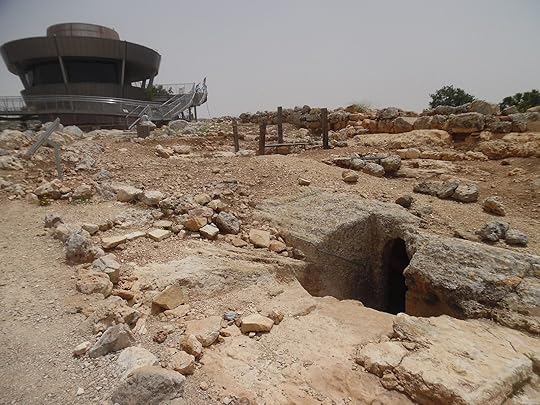 A cave sits below the place of the Tabernacle at ShiloOne of the things I personally was interested in was the road that led to Shilo. I wrote about the trip of Joseph and Mary in my book Advent Journeys. I was pleased to see it was like the pictures I researched for the book. The site of Shilo was interesting also.
A cave sits below the place of the Tabernacle at ShiloOne of the things I personally was interested in was the road that led to Shilo. I wrote about the trip of Joseph and Mary in my book Advent Journeys. I was pleased to see it was like the pictures I researched for the book. The site of Shilo was interesting also.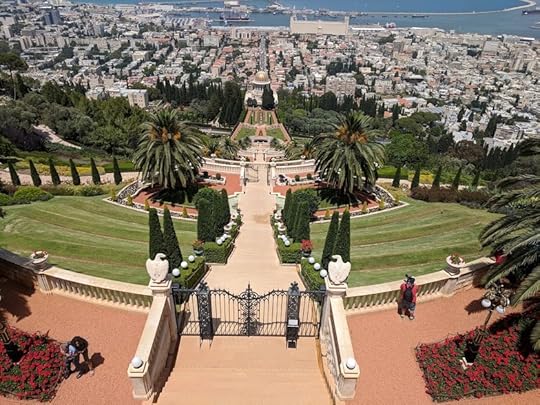 Baha'i Gardens in Haifa with the port area belowA second new place I visited was Haifa. I visited the Baha'i Gardens, hiked the Haifa Trail, ate great food at the top of the hill, and looked down at the great harbor below. The gardens were beautiful and very well kept. I walked down the 750 steps in the garden, and walked up the alternate trail that led back to the top of the hill. I enjoyed swimming at the beach.
Baha'i Gardens in Haifa with the port area belowA second new place I visited was Haifa. I visited the Baha'i Gardens, hiked the Haifa Trail, ate great food at the top of the hill, and looked down at the great harbor below. The gardens were beautiful and very well kept. I walked down the 750 steps in the garden, and walked up the alternate trail that led back to the top of the hill. I enjoyed swimming at the beach.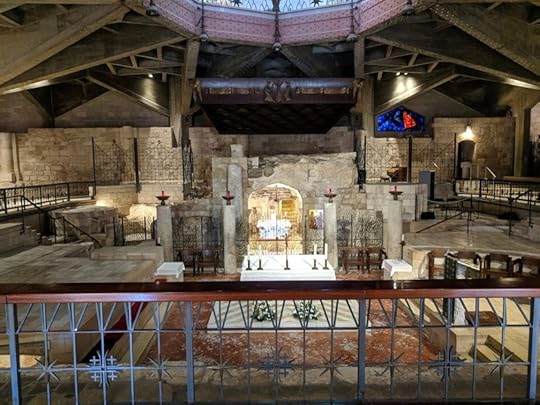 The house in the Church of the Annunciation at NazarethI participated in archaeological digs at Tel Gezer, Tel Hadid, Zippori, and at Tel Dan. Zippori was the most interesting dig, and I will write about that in another post. While at Zippori I visited the Church of the Annunciation. The sanctuary is beautiful. The small house in the church as well as Joseph’s carpentry shop in the basement of another church are both interesting.
The house in the Church of the Annunciation at NazarethI participated in archaeological digs at Tel Gezer, Tel Hadid, Zippori, and at Tel Dan. Zippori was the most interesting dig, and I will write about that in another post. While at Zippori I visited the Church of the Annunciation. The sanctuary is beautiful. The small house in the church as well as Joseph’s carpentry shop in the basement of another church are both interesting.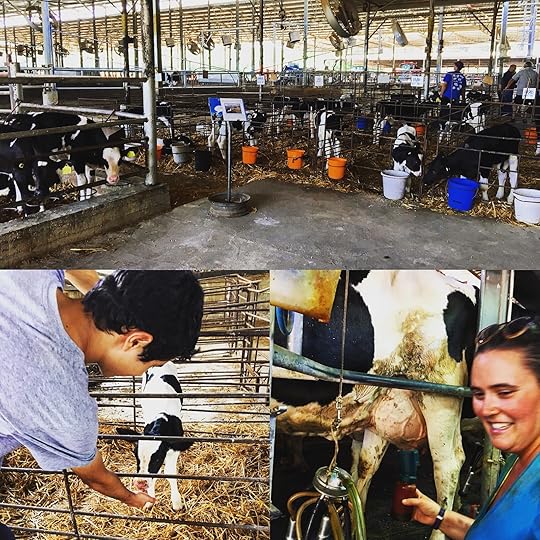 Kurlander Dairy in Northern Israel
Kurlander Dairy in Northern Israel
I spent about ten days near Tel Dan and enjoyed the beautiful countryside in Northern Israel. While there I took a long hike a Banias and saw the waterfalls. I also entered Dan at the Canaanite Gate, visited Kerlander Dairy, Hermon Field School and various restaurants and shopping centers in the area.

 Some of the places I visited during the two weeks of my tour were places I visited before, but since I helped plan the tour, there were some new places also.
Some of the places I visited during the two weeks of my tour were places I visited before, but since I helped plan the tour, there were some new places also.  The Archaeological site at ShiloOne of the places I looked forward to seeing was Shilo, the site where Joshua set up the Tabernacle and where young Samuel heard the voice of the Lord. The Tabernacle is long gone, but the hills still stand at this site, the ruins have been made visible and the stories about Israel’s place of worship are still remembered.
The Archaeological site at ShiloOne of the places I looked forward to seeing was Shilo, the site where Joshua set up the Tabernacle and where young Samuel heard the voice of the Lord. The Tabernacle is long gone, but the hills still stand at this site, the ruins have been made visible and the stories about Israel’s place of worship are still remembered. A cave sits below the place of the Tabernacle at ShiloOne of the things I personally was interested in was the road that led to Shilo. I wrote about the trip of Joseph and Mary in my book Advent Journeys. I was pleased to see it was like the pictures I researched for the book. The site of Shilo was interesting also.
A cave sits below the place of the Tabernacle at ShiloOne of the things I personally was interested in was the road that led to Shilo. I wrote about the trip of Joseph and Mary in my book Advent Journeys. I was pleased to see it was like the pictures I researched for the book. The site of Shilo was interesting also. Baha'i Gardens in Haifa with the port area belowA second new place I visited was Haifa. I visited the Baha'i Gardens, hiked the Haifa Trail, ate great food at the top of the hill, and looked down at the great harbor below. The gardens were beautiful and very well kept. I walked down the 750 steps in the garden, and walked up the alternate trail that led back to the top of the hill. I enjoyed swimming at the beach.
Baha'i Gardens in Haifa with the port area belowA second new place I visited was Haifa. I visited the Baha'i Gardens, hiked the Haifa Trail, ate great food at the top of the hill, and looked down at the great harbor below. The gardens were beautiful and very well kept. I walked down the 750 steps in the garden, and walked up the alternate trail that led back to the top of the hill. I enjoyed swimming at the beach. The house in the Church of the Annunciation at NazarethI participated in archaeological digs at Tel Gezer, Tel Hadid, Zippori, and at Tel Dan. Zippori was the most interesting dig, and I will write about that in another post. While at Zippori I visited the Church of the Annunciation. The sanctuary is beautiful. The small house in the church as well as Joseph’s carpentry shop in the basement of another church are both interesting.
The house in the Church of the Annunciation at NazarethI participated in archaeological digs at Tel Gezer, Tel Hadid, Zippori, and at Tel Dan. Zippori was the most interesting dig, and I will write about that in another post. While at Zippori I visited the Church of the Annunciation. The sanctuary is beautiful. The small house in the church as well as Joseph’s carpentry shop in the basement of another church are both interesting. Kurlander Dairy in Northern Israel
Kurlander Dairy in Northern IsraelI spent about ten days near Tel Dan and enjoyed the beautiful countryside in Northern Israel. While there I took a long hike a Banias and saw the waterfalls. I also entered Dan at the Canaanite Gate, visited Kerlander Dairy, Hermon Field School and various restaurants and shopping centers in the area.
Published on October 24, 2018 11:55
June 15, 2018
Tel Hadid
I have just completed a week of an archaeological probe at Tel Hadid, Israel.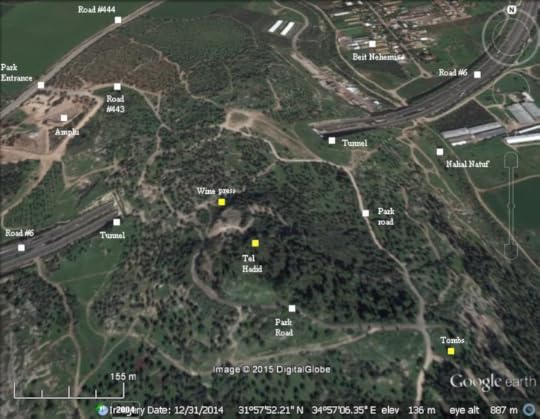 A map of Tel HadidTel Hadid is located on a hill on the north side of the entrance to the Ayalon Valley. Tel Gezer is located on the south side of this important transportation zone which leads up the hill to Jerusalem.
A map of Tel HadidTel Hadid is located on a hill on the north side of the entrance to the Ayalon Valley. Tel Gezer is located on the south side of this important transportation zone which leads up the hill to Jerusalem. 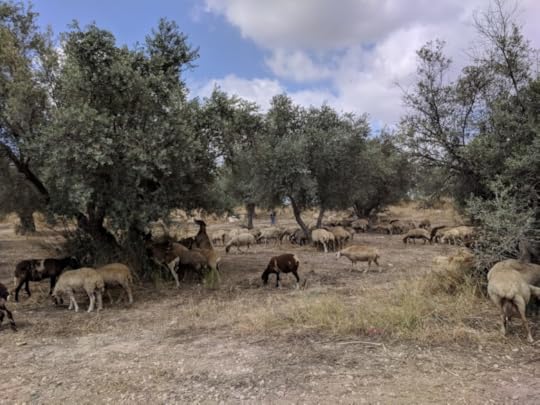 Sheep grazing on olive trees at Tel HadidThe ancient walled city is listed in the Mishnah (Arachin 9:6) as existing in the time of Joshua. Archaeological researchers are interested in the site because several land transfer documents have been found which date back to the times of King Hezekiah, and to the Assyrian and Babylonian conquests of the land of Israel.
Sheep grazing on olive trees at Tel HadidThe ancient walled city is listed in the Mishnah (Arachin 9:6) as existing in the time of Joshua. Archaeological researchers are interested in the site because several land transfer documents have been found which date back to the times of King Hezekiah, and to the Assyrian and Babylonian conquests of the land of Israel.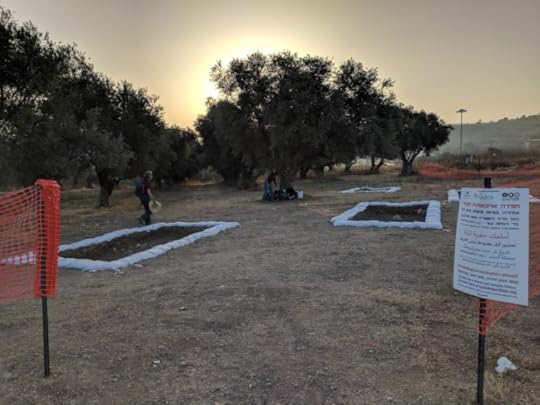 Test probes at Tel HadidIt is thought that after the deportation of the ten northern tribes of Israel that the Assyrians placed a diverse group of people from many nationalities in the land called Samaria. They did this to prevent uprisings in occupied territories. The cultural identity of the people took years to develop into anything more than displaced peoples.
Test probes at Tel HadidIt is thought that after the deportation of the ten northern tribes of Israel that the Assyrians placed a diverse group of people from many nationalities in the land called Samaria. They did this to prevent uprisings in occupied territories. The cultural identity of the people took years to develop into anything more than displaced peoples.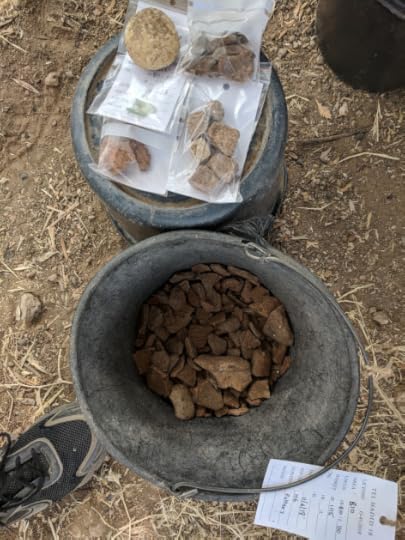 A day's finds from our hole at Tel HadidThe Maccabees had a presence in this city, which they called Adiada, which is close to Modi’in. Coins and other remains have been found from this period, one of which was a coin found in the probe I was assigned to dig. I asked if the Maccabean coin was from Judah or Simon, and was told I would have to wait until the final reprot.
A day's finds from our hole at Tel HadidThe Maccabees had a presence in this city, which they called Adiada, which is close to Modi’in. Coins and other remains have been found from this period, one of which was a coin found in the probe I was assigned to dig. I asked if the Maccabean coin was from Judah or Simon, and was told I would have to wait until the final reprot.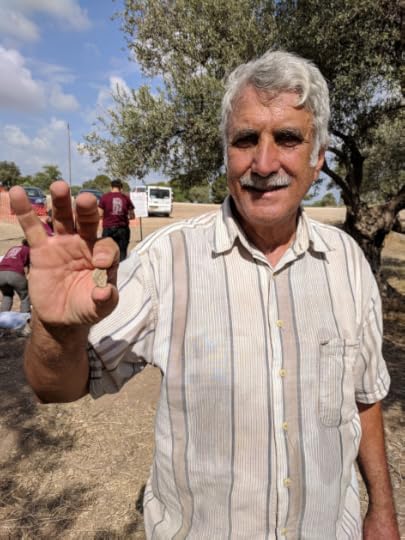 A Hasmonean Coin from our hole at Tel HadidOther coins and metal objects, some extremely rare were also found during our dig.
A Hasmonean Coin from our hole at Tel HadidOther coins and metal objects, some extremely rare were also found during our dig.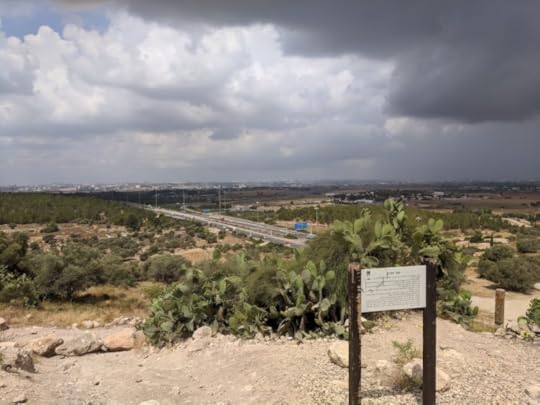 Highway 6 runs under Tel Hadid
Highway 6 runs under Tel Hadid
The work at Tel Hadid began as a salvage operation about twenty years ago, as Israel Highway 6 was being planned. Tel Aviv University is mapping and performing test probes in this area, and will begin an actual dig next year. You can go to their website for more information, or if you want to dig at this place. New Orleans Baptist Theological Seminary will be working with Tel Aviv University as they dig.
 A map of Tel HadidTel Hadid is located on a hill on the north side of the entrance to the Ayalon Valley. Tel Gezer is located on the south side of this important transportation zone which leads up the hill to Jerusalem.
A map of Tel HadidTel Hadid is located on a hill on the north side of the entrance to the Ayalon Valley. Tel Gezer is located on the south side of this important transportation zone which leads up the hill to Jerusalem.  Sheep grazing on olive trees at Tel HadidThe ancient walled city is listed in the Mishnah (Arachin 9:6) as existing in the time of Joshua. Archaeological researchers are interested in the site because several land transfer documents have been found which date back to the times of King Hezekiah, and to the Assyrian and Babylonian conquests of the land of Israel.
Sheep grazing on olive trees at Tel HadidThe ancient walled city is listed in the Mishnah (Arachin 9:6) as existing in the time of Joshua. Archaeological researchers are interested in the site because several land transfer documents have been found which date back to the times of King Hezekiah, and to the Assyrian and Babylonian conquests of the land of Israel. Test probes at Tel HadidIt is thought that after the deportation of the ten northern tribes of Israel that the Assyrians placed a diverse group of people from many nationalities in the land called Samaria. They did this to prevent uprisings in occupied territories. The cultural identity of the people took years to develop into anything more than displaced peoples.
Test probes at Tel HadidIt is thought that after the deportation of the ten northern tribes of Israel that the Assyrians placed a diverse group of people from many nationalities in the land called Samaria. They did this to prevent uprisings in occupied territories. The cultural identity of the people took years to develop into anything more than displaced peoples. A day's finds from our hole at Tel HadidThe Maccabees had a presence in this city, which they called Adiada, which is close to Modi’in. Coins and other remains have been found from this period, one of which was a coin found in the probe I was assigned to dig. I asked if the Maccabean coin was from Judah or Simon, and was told I would have to wait until the final reprot.
A day's finds from our hole at Tel HadidThe Maccabees had a presence in this city, which they called Adiada, which is close to Modi’in. Coins and other remains have been found from this period, one of which was a coin found in the probe I was assigned to dig. I asked if the Maccabean coin was from Judah or Simon, and was told I would have to wait until the final reprot. A Hasmonean Coin from our hole at Tel HadidOther coins and metal objects, some extremely rare were also found during our dig.
A Hasmonean Coin from our hole at Tel HadidOther coins and metal objects, some extremely rare were also found during our dig. Highway 6 runs under Tel Hadid
Highway 6 runs under Tel HadidThe work at Tel Hadid began as a salvage operation about twenty years ago, as Israel Highway 6 was being planned. Tel Aviv University is mapping and performing test probes in this area, and will begin an actual dig next year. You can go to their website for more information, or if you want to dig at this place. New Orleans Baptist Theological Seminary will be working with Tel Aviv University as they dig.
Published on June 15, 2018 22:36
June 10, 2018
A Hasmonean Fortress
Yesterday was Shabbat, a day of rest and enjoyment in Israel. The group I am digging with drove to Masada, Caesarea and Ashkelon. Because I have visited two of these sites, I decided to take another walk, across Highway 1 to Ayalon Canada Park.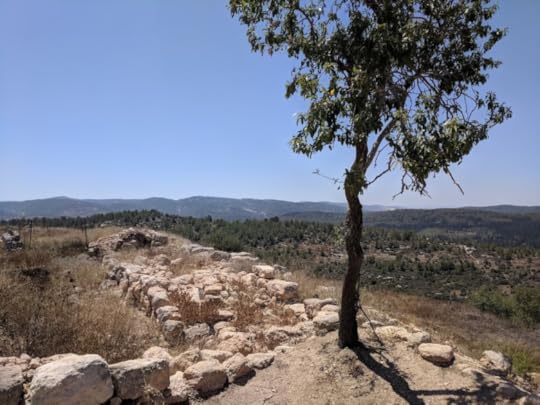 Wall at the Hasmonean Fortress in Ayalon ParkThe park contains several ancient and not so ancient places.
Wall at the Hasmonean Fortress in Ayalon ParkThe park contains several ancient and not so ancient places.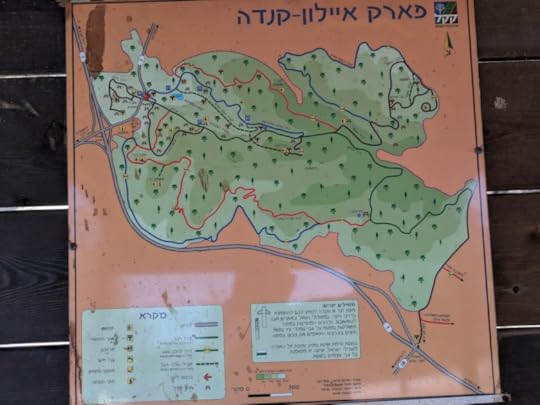 Map of Ayalon Canada ParkThe park is located on a ridge near the Ayalon Stream. Citizens of Canada planted trees along the ridges of this park through the Jewish National Fund.
Map of Ayalon Canada ParkThe park is located on a ridge near the Ayalon Stream. Citizens of Canada planted trees along the ridges of this park through the Jewish National Fund.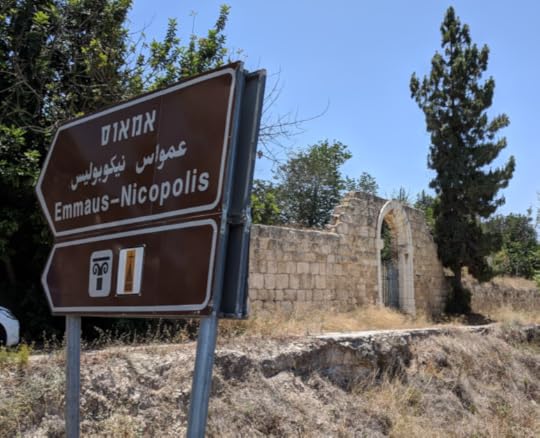 Chapel at EmmausThe park is located near a place called “Emmaus.” Some consider this the place that two disciples visited with Jesus after his Resurrection (Luke 24). Various scholars debate this and list at least two other potential sites for Emmaus. There are remains of an ancient chapel and a modern church next to the park.
Chapel at EmmausThe park is located near a place called “Emmaus.” Some consider this the place that two disciples visited with Jesus after his Resurrection (Luke 24). Various scholars debate this and list at least two other potential sites for Emmaus. There are remains of an ancient chapel and a modern church next to the park.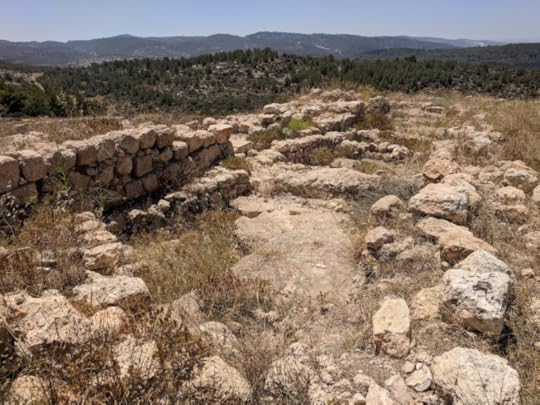 Hasmonean Fortress near EmmausEmmaus is mentioned in the books of the Maccabees. 1 Maccabees 4 says, “Gorgias (the Seleucid general) took five thousand infantry and one thousand select cavalry, and this division moved out secretly at night. He wanted to come to the Jewish camp and attack without warning. Men from the elevated fortress served as his guides. But Judas heard about it, and he and his warriors moved out to attack the king’s forces in Emmaus…”
Hasmonean Fortress near EmmausEmmaus is mentioned in the books of the Maccabees. 1 Maccabees 4 says, “Gorgias (the Seleucid general) took five thousand infantry and one thousand select cavalry, and this division moved out secretly at night. He wanted to come to the Jewish camp and attack without warning. Men from the elevated fortress served as his guides. But Judas heard about it, and he and his warriors moved out to attack the king’s forces in Emmaus…”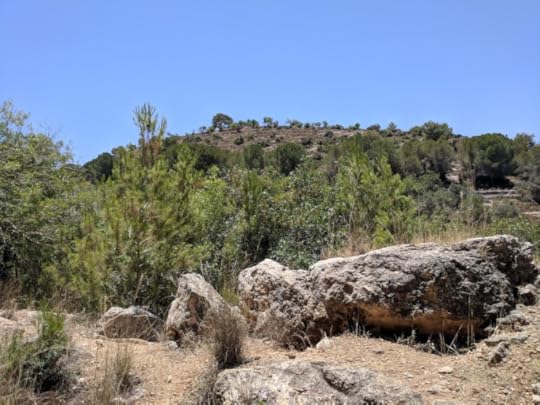 Hasmonean remains in Canada ParkI visited the Hasmonean fortress built around 165 BCE which is located on a high hill.
Hasmonean remains in Canada ParkI visited the Hasmonean fortress built around 165 BCE which is located on a high hill.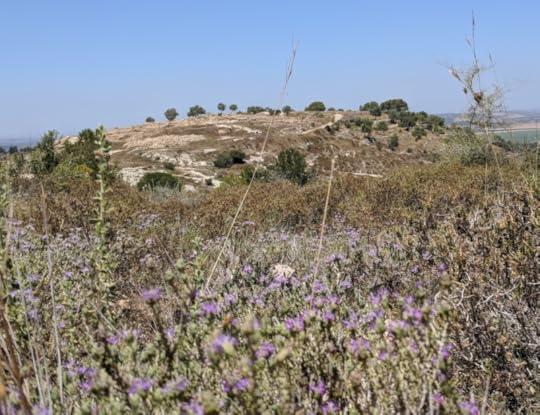 Hilltop with a Hasmonean fortressNeve Shalom, the hotel of our residence while on our current archaeological dig is clearly visible from this high location.
Hilltop with a Hasmonean fortressNeve Shalom, the hotel of our residence while on our current archaeological dig is clearly visible from this high location.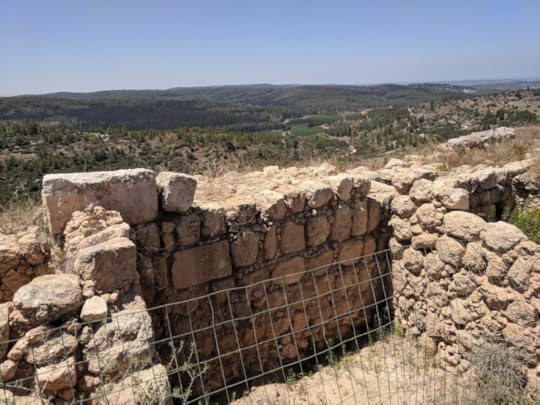 Hasmonean Building near EmmausThere are walls,
Hasmonean Building near EmmausThere are walls,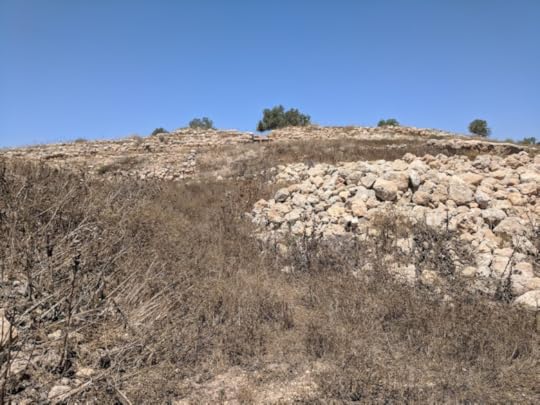 Hasmonean FortressBuildings,
Hasmonean FortressBuildings,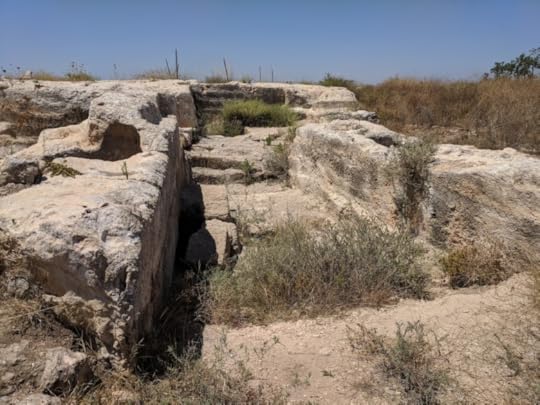 Hasmonean Buildings carved from stoneCaves,
Hasmonean Buildings carved from stoneCaves,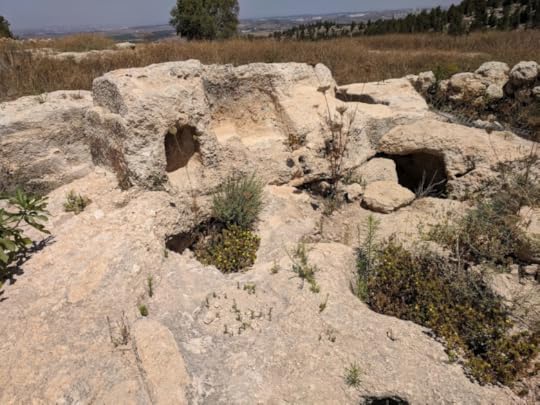 Caves for hiding in the Hasmonean FortressAnd even a Mikvah pool within the Hasmonean Fortress.
Caves for hiding in the Hasmonean FortressAnd even a Mikvah pool within the Hasmonean Fortress.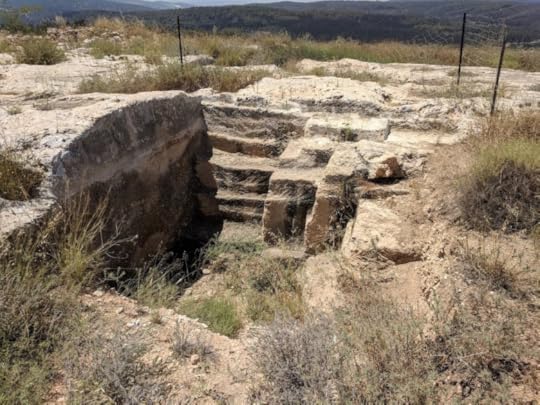 Mikvah Pool in the Hasmonean FortressThe fortress was also used during the Bar Kochba in 135 AD.
Mikvah Pool in the Hasmonean FortressThe fortress was also used during the Bar Kochba in 135 AD.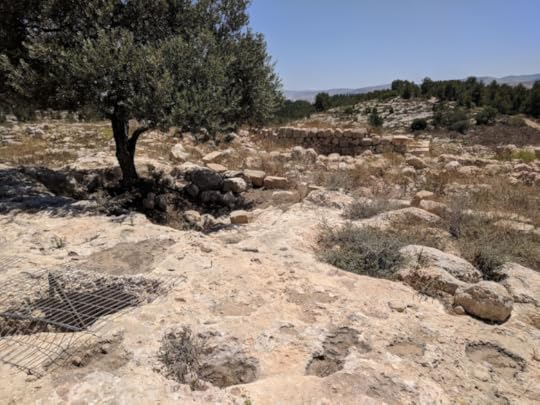 Bar Kochba escape holeBar Kochba’s soldiers dug escape routes under the ground,
Bar Kochba escape holeBar Kochba’s soldiers dug escape routes under the ground,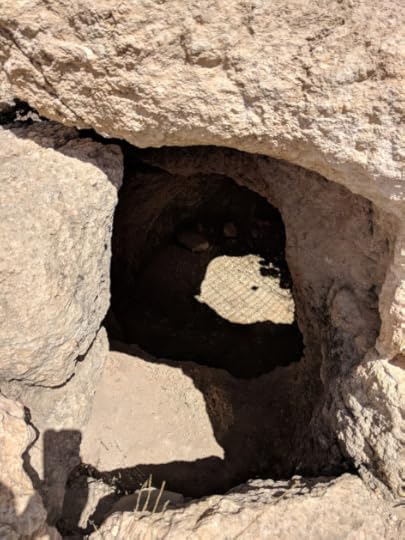 Bar Kochba escape CaveWhich are entered through holes in the ground.
Bar Kochba escape CaveWhich are entered through holes in the ground.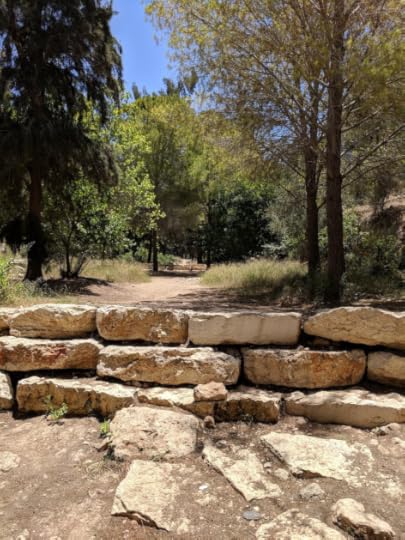 Retaining Ponds in a valleyThere are several springs in the park, and an elaborate system of aqueducts
Retaining Ponds in a valleyThere are several springs in the park, and an elaborate system of aqueducts 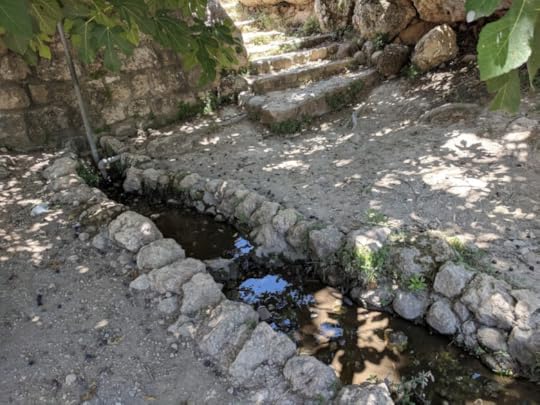 Roman aqueduct in Ayalon Canada ParkBuilt by the Romans.
Roman aqueduct in Ayalon Canada ParkBuilt by the Romans.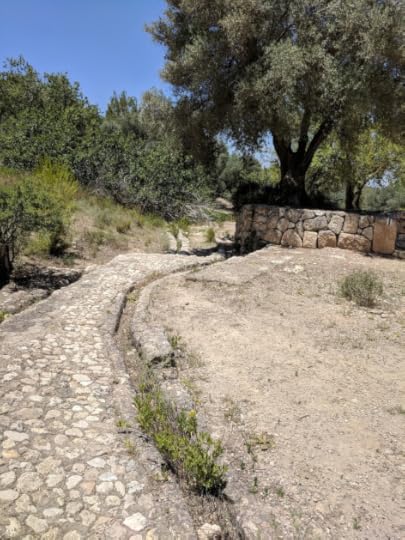 Second Century Roman aqueductThe splendor of the system can be easily seen,
Second Century Roman aqueductThe splendor of the system can be easily seen,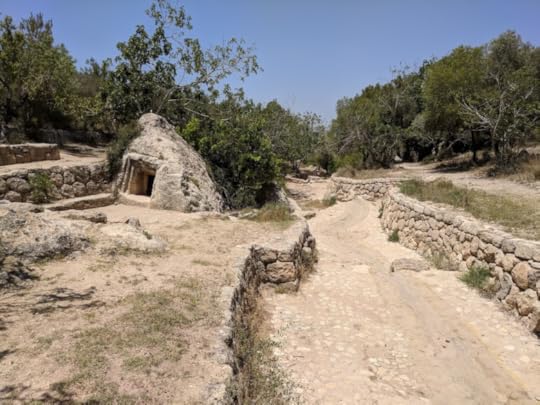 Roman aqueduct in Ayalon Canada Park(I walked down the hill along the water system),
Roman aqueduct in Ayalon Canada Park(I walked down the hill along the water system),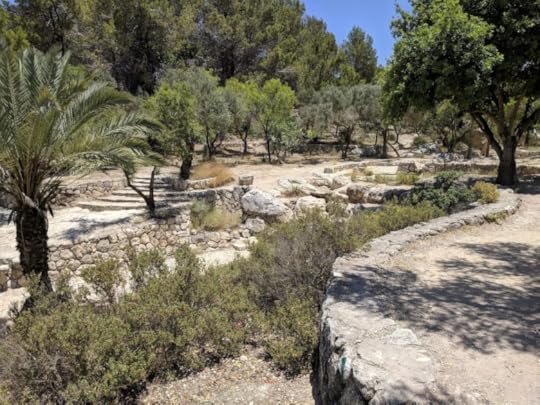 Roman aqueduct in Ayalon Canada ParkAnd there is a beautiful pool and plaza at the end.
Roman aqueduct in Ayalon Canada ParkAnd there is a beautiful pool and plaza at the end.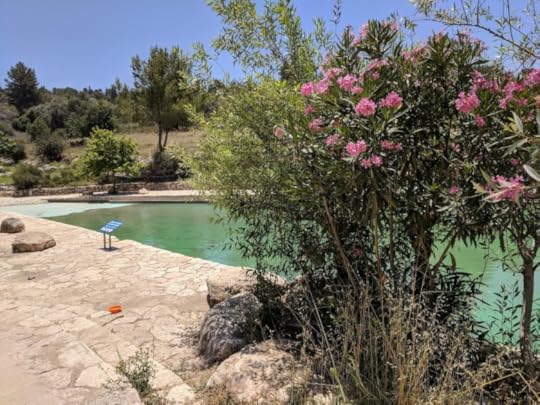 Pool at the end of the Roman aqueduct
Pool at the end of the Roman aqueduct
Canada Park is located close to Modi’in, which is the city of Chanukah.
 Wall at the Hasmonean Fortress in Ayalon ParkThe park contains several ancient and not so ancient places.
Wall at the Hasmonean Fortress in Ayalon ParkThe park contains several ancient and not so ancient places. Map of Ayalon Canada ParkThe park is located on a ridge near the Ayalon Stream. Citizens of Canada planted trees along the ridges of this park through the Jewish National Fund.
Map of Ayalon Canada ParkThe park is located on a ridge near the Ayalon Stream. Citizens of Canada planted trees along the ridges of this park through the Jewish National Fund. Chapel at EmmausThe park is located near a place called “Emmaus.” Some consider this the place that two disciples visited with Jesus after his Resurrection (Luke 24). Various scholars debate this and list at least two other potential sites for Emmaus. There are remains of an ancient chapel and a modern church next to the park.
Chapel at EmmausThe park is located near a place called “Emmaus.” Some consider this the place that two disciples visited with Jesus after his Resurrection (Luke 24). Various scholars debate this and list at least two other potential sites for Emmaus. There are remains of an ancient chapel and a modern church next to the park. Hasmonean Fortress near EmmausEmmaus is mentioned in the books of the Maccabees. 1 Maccabees 4 says, “Gorgias (the Seleucid general) took five thousand infantry and one thousand select cavalry, and this division moved out secretly at night. He wanted to come to the Jewish camp and attack without warning. Men from the elevated fortress served as his guides. But Judas heard about it, and he and his warriors moved out to attack the king’s forces in Emmaus…”
Hasmonean Fortress near EmmausEmmaus is mentioned in the books of the Maccabees. 1 Maccabees 4 says, “Gorgias (the Seleucid general) took five thousand infantry and one thousand select cavalry, and this division moved out secretly at night. He wanted to come to the Jewish camp and attack without warning. Men from the elevated fortress served as his guides. But Judas heard about it, and he and his warriors moved out to attack the king’s forces in Emmaus…” Hasmonean remains in Canada ParkI visited the Hasmonean fortress built around 165 BCE which is located on a high hill.
Hasmonean remains in Canada ParkI visited the Hasmonean fortress built around 165 BCE which is located on a high hill. Hilltop with a Hasmonean fortressNeve Shalom, the hotel of our residence while on our current archaeological dig is clearly visible from this high location.
Hilltop with a Hasmonean fortressNeve Shalom, the hotel of our residence while on our current archaeological dig is clearly visible from this high location. Hasmonean Building near EmmausThere are walls,
Hasmonean Building near EmmausThere are walls, Hasmonean FortressBuildings,
Hasmonean FortressBuildings, Hasmonean Buildings carved from stoneCaves,
Hasmonean Buildings carved from stoneCaves, Caves for hiding in the Hasmonean FortressAnd even a Mikvah pool within the Hasmonean Fortress.
Caves for hiding in the Hasmonean FortressAnd even a Mikvah pool within the Hasmonean Fortress. Mikvah Pool in the Hasmonean FortressThe fortress was also used during the Bar Kochba in 135 AD.
Mikvah Pool in the Hasmonean FortressThe fortress was also used during the Bar Kochba in 135 AD. Bar Kochba escape holeBar Kochba’s soldiers dug escape routes under the ground,
Bar Kochba escape holeBar Kochba’s soldiers dug escape routes under the ground, Bar Kochba escape CaveWhich are entered through holes in the ground.
Bar Kochba escape CaveWhich are entered through holes in the ground. Retaining Ponds in a valleyThere are several springs in the park, and an elaborate system of aqueducts
Retaining Ponds in a valleyThere are several springs in the park, and an elaborate system of aqueducts  Roman aqueduct in Ayalon Canada ParkBuilt by the Romans.
Roman aqueduct in Ayalon Canada ParkBuilt by the Romans. Second Century Roman aqueductThe splendor of the system can be easily seen,
Second Century Roman aqueductThe splendor of the system can be easily seen, Roman aqueduct in Ayalon Canada Park(I walked down the hill along the water system),
Roman aqueduct in Ayalon Canada Park(I walked down the hill along the water system), Roman aqueduct in Ayalon Canada ParkAnd there is a beautiful pool and plaza at the end.
Roman aqueduct in Ayalon Canada ParkAnd there is a beautiful pool and plaza at the end. Pool at the end of the Roman aqueduct
Pool at the end of the Roman aqueductCanada Park is located close to Modi’in, which is the city of Chanukah.
Published on June 10, 2018 07:06
June 8, 2018
A Train Ride in Israel
Two of my favorite places in Israel are train stations, the first train stations in Tel-Aviv and Jerusalem. 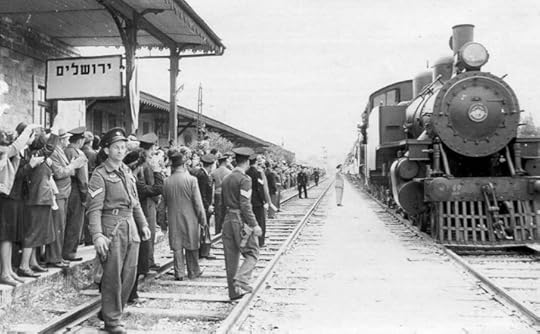 Old picture of Train Station in JerusalemToday train service is no longer available at these stations, and both train stations are shopping centers.
Old picture of Train Station in JerusalemToday train service is no longer available at these stations, and both train stations are shopping centers.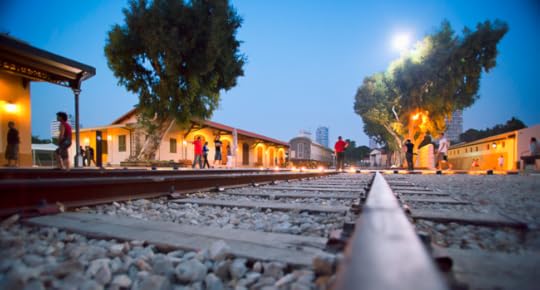 Old Train Station JaffaBut both train stations, especially the depot in Jerusalem are cultural centers as well as train stations.
Old Train Station JaffaBut both train stations, especially the depot in Jerusalem are cultural centers as well as train stations.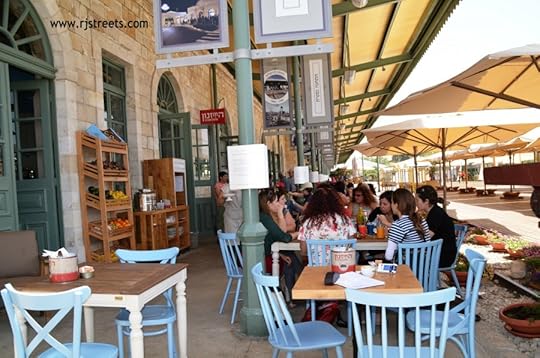 First Train Station, JerusalemMy family and I have attended a film festival, a book fair and and several concerts in the First Train Station.
First Train Station, JerusalemMy family and I have attended a film festival, a book fair and and several concerts in the First Train Station.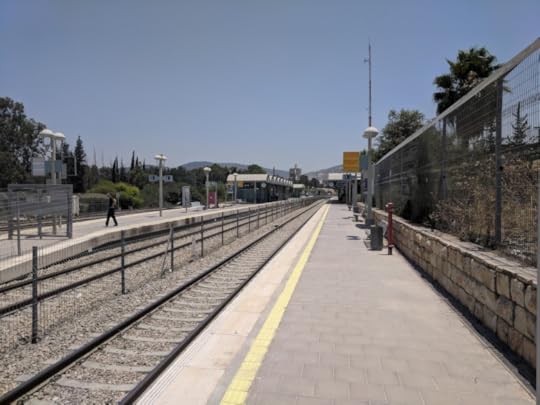 Beit Shemesh train station looking eastRailroad service was first proposed for the land of Israel by Moses Montefiore in the 1830’s. At that time travel within the land of Israel was by foot or by camels. The trip to Jerusalem was long and hard.
Beit Shemesh train station looking eastRailroad service was first proposed for the land of Israel by Moses Montefiore in the 1830’s. At that time travel within the land of Israel was by foot or by camels. The trip to Jerusalem was long and hard.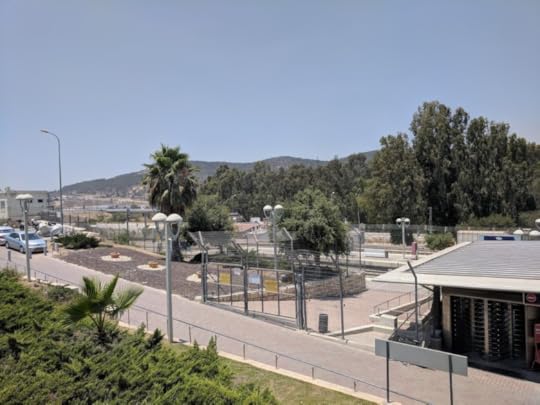 Bet Shemesh Train Station looking NorthThe route a ride from the port city of Jaffa crossed the Plain of Sharon from the port of Yafo to Lod (or Lydda).
Bet Shemesh Train Station looking NorthThe route a ride from the port city of Jaffa crossed the Plain of Sharon from the port of Yafo to Lod (or Lydda).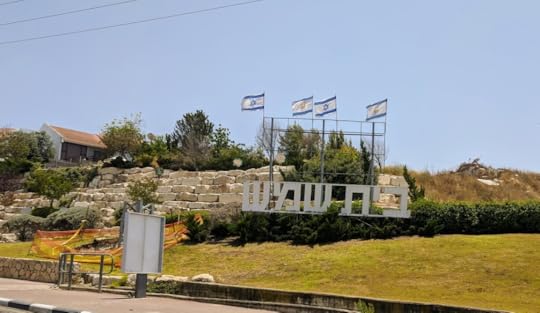 Beit Shemesh city signThen the road entered the Sorek Valley, ascending to Beit Shemesh.
Beit Shemesh city signThen the road entered the Sorek Valley, ascending to Beit Shemesh.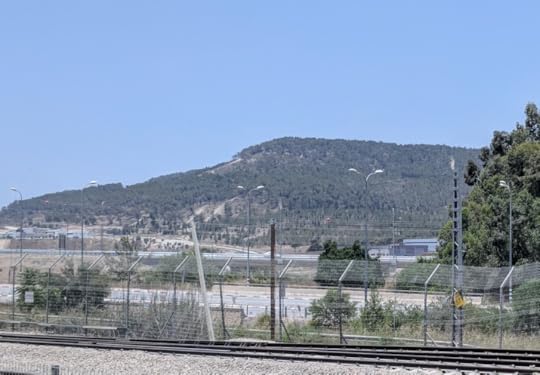 Zorah is on this MountainThis is the land of Samson and Delilah.
Zorah is on this MountainThis is the land of Samson and Delilah.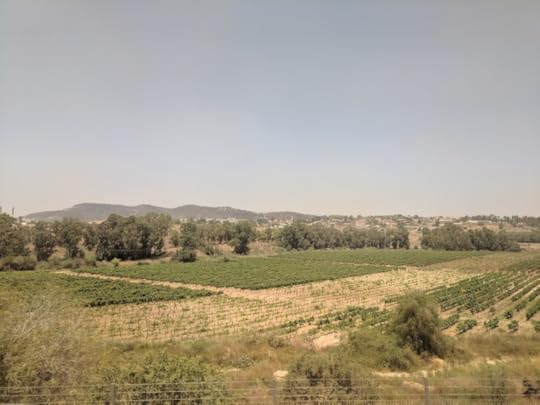 Farmland approaching Beit ShemeshBeit Shemesh is listed as a city both in the territory of Dan and in the Judean Hill country.
Farmland approaching Beit ShemeshBeit Shemesh is listed as a city both in the territory of Dan and in the Judean Hill country.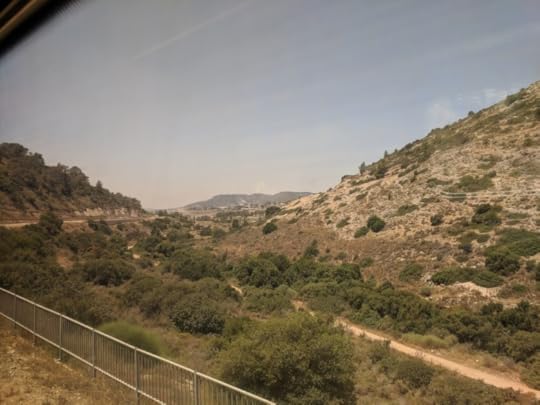 Judean Hills - Zorah in backgroundThe train ascends the Judean hills along the sorek river.
Judean Hills - Zorah in backgroundThe train ascends the Judean hills along the sorek river.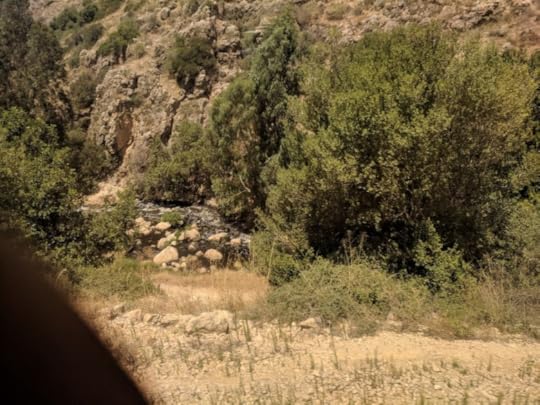 Sorek River running through the Judean HillsThe ride is very beautiful. There are some olive groves along the way,
Sorek River running through the Judean HillsThe ride is very beautiful. There are some olive groves along the way,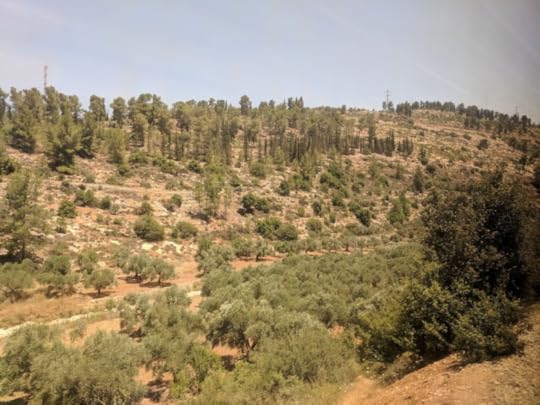 Olive Groves along Railroad LineBut not many houses, for this is rugged country.
Olive Groves along Railroad LineBut not many houses, for this is rugged country.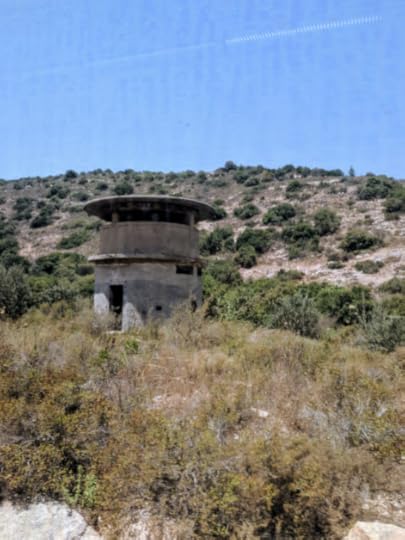 Defensive Structure in Judean HillsI was advised many times not to take the train, because the ride from Jerusalem to Beit Shemesh on the train takes longer than a bus ride. (about an hour) To get from the train station in Beit Shemesh to the airport requires three or four train transfers.
Defensive Structure in Judean HillsI was advised many times not to take the train, because the ride from Jerusalem to Beit Shemesh on the train takes longer than a bus ride. (about an hour) To get from the train station in Beit Shemesh to the airport requires three or four train transfers.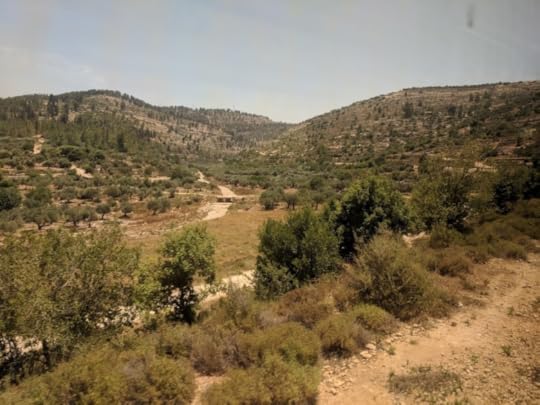 Old Railroad leaving Jerusalem HighlandsWe were not taking the ride to meet a time schedule, only to see the beauty.
Old Railroad leaving Jerusalem HighlandsWe were not taking the ride to meet a time schedule, only to see the beauty.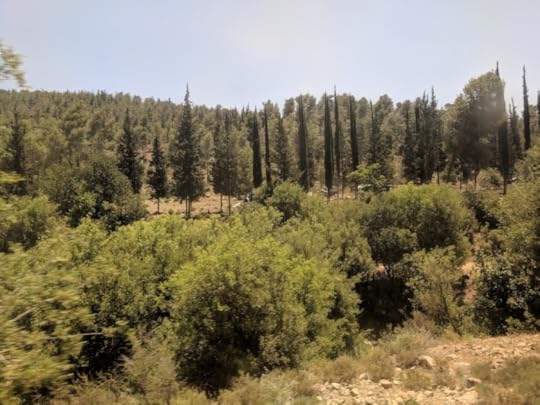 Beauty from train windowThe train was for the most part empty because of people’s attitudes. That was ok for us, as we could take pictures from both sides of the train through the windows.
Beauty from train windowThe train was for the most part empty because of people’s attitudes. That was ok for us, as we could take pictures from both sides of the train through the windows. Train from Jerusalem to Beit ShemeshNear the top of the hill the train stops at a terminal across the street from the Biblical Zoo.
Train from Jerusalem to Beit ShemeshNear the top of the hill the train stops at a terminal across the street from the Biblical Zoo.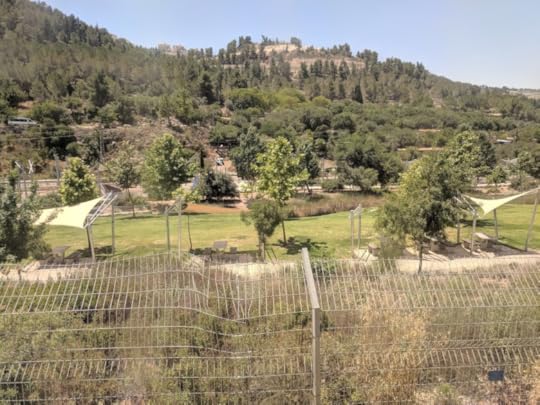 Looking across tracks from Biblical Zoo in JerusalemThe final stop is near German Colony.
Looking across tracks from Biblical Zoo in JerusalemThe final stop is near German Colony.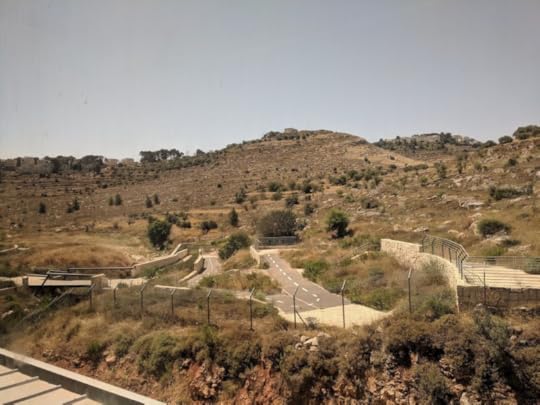 Looking at park behind Jerusalem Train StationWe enjoyed the smooth and beautiful ride very much.
Looking at park behind Jerusalem Train StationWe enjoyed the smooth and beautiful ride very much.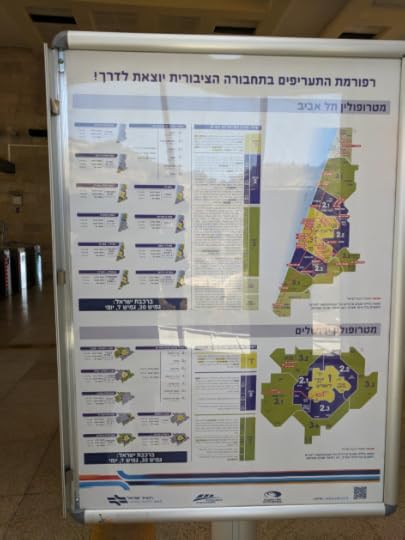 Map of Israel Train zones
Map of Israel Train zones
In the near future there will be a high speed train from Jerusalem to the airport. Don’t know, but possibly train service on the old line will come to an end at that time.
 Old picture of Train Station in JerusalemToday train service is no longer available at these stations, and both train stations are shopping centers.
Old picture of Train Station in JerusalemToday train service is no longer available at these stations, and both train stations are shopping centers. Old Train Station JaffaBut both train stations, especially the depot in Jerusalem are cultural centers as well as train stations.
Old Train Station JaffaBut both train stations, especially the depot in Jerusalem are cultural centers as well as train stations. First Train Station, JerusalemMy family and I have attended a film festival, a book fair and and several concerts in the First Train Station.
First Train Station, JerusalemMy family and I have attended a film festival, a book fair and and several concerts in the First Train Station. Beit Shemesh train station looking eastRailroad service was first proposed for the land of Israel by Moses Montefiore in the 1830’s. At that time travel within the land of Israel was by foot or by camels. The trip to Jerusalem was long and hard.
Beit Shemesh train station looking eastRailroad service was first proposed for the land of Israel by Moses Montefiore in the 1830’s. At that time travel within the land of Israel was by foot or by camels. The trip to Jerusalem was long and hard. Bet Shemesh Train Station looking NorthThe route a ride from the port city of Jaffa crossed the Plain of Sharon from the port of Yafo to Lod (or Lydda).
Bet Shemesh Train Station looking NorthThe route a ride from the port city of Jaffa crossed the Plain of Sharon from the port of Yafo to Lod (or Lydda). Beit Shemesh city signThen the road entered the Sorek Valley, ascending to Beit Shemesh.
Beit Shemesh city signThen the road entered the Sorek Valley, ascending to Beit Shemesh. Zorah is on this MountainThis is the land of Samson and Delilah.
Zorah is on this MountainThis is the land of Samson and Delilah. Farmland approaching Beit ShemeshBeit Shemesh is listed as a city both in the territory of Dan and in the Judean Hill country.
Farmland approaching Beit ShemeshBeit Shemesh is listed as a city both in the territory of Dan and in the Judean Hill country. Judean Hills - Zorah in backgroundThe train ascends the Judean hills along the sorek river.
Judean Hills - Zorah in backgroundThe train ascends the Judean hills along the sorek river. Sorek River running through the Judean HillsThe ride is very beautiful. There are some olive groves along the way,
Sorek River running through the Judean HillsThe ride is very beautiful. There are some olive groves along the way, Olive Groves along Railroad LineBut not many houses, for this is rugged country.
Olive Groves along Railroad LineBut not many houses, for this is rugged country. Defensive Structure in Judean HillsI was advised many times not to take the train, because the ride from Jerusalem to Beit Shemesh on the train takes longer than a bus ride. (about an hour) To get from the train station in Beit Shemesh to the airport requires three or four train transfers.
Defensive Structure in Judean HillsI was advised many times not to take the train, because the ride from Jerusalem to Beit Shemesh on the train takes longer than a bus ride. (about an hour) To get from the train station in Beit Shemesh to the airport requires three or four train transfers. Old Railroad leaving Jerusalem HighlandsWe were not taking the ride to meet a time schedule, only to see the beauty.
Old Railroad leaving Jerusalem HighlandsWe were not taking the ride to meet a time schedule, only to see the beauty. Beauty from train windowThe train was for the most part empty because of people’s attitudes. That was ok for us, as we could take pictures from both sides of the train through the windows.
Beauty from train windowThe train was for the most part empty because of people’s attitudes. That was ok for us, as we could take pictures from both sides of the train through the windows. Train from Jerusalem to Beit ShemeshNear the top of the hill the train stops at a terminal across the street from the Biblical Zoo.
Train from Jerusalem to Beit ShemeshNear the top of the hill the train stops at a terminal across the street from the Biblical Zoo. Looking across tracks from Biblical Zoo in JerusalemThe final stop is near German Colony.
Looking across tracks from Biblical Zoo in JerusalemThe final stop is near German Colony. Looking at park behind Jerusalem Train StationWe enjoyed the smooth and beautiful ride very much.
Looking at park behind Jerusalem Train StationWe enjoyed the smooth and beautiful ride very much. Map of Israel Train zones
Map of Israel Train zonesIn the near future there will be a high speed train from Jerusalem to the airport. Don’t know, but possibly train service on the old line will come to an end at that time.
Published on June 08, 2018 08:53
June 6, 2018
A visit to the top of Mount Scopus
Today we went to the top of Mount Scopus and visited Hebrew University.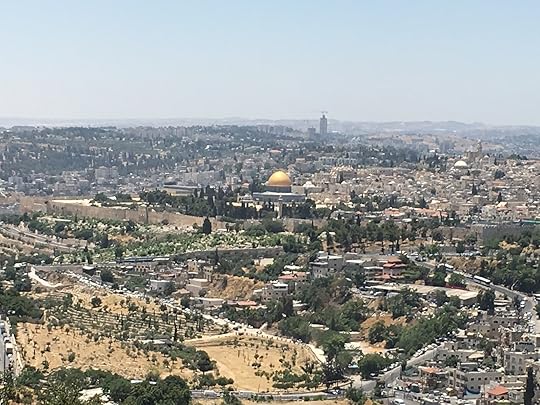 Jerusalem from the top of Mount ScopusAt 2710 feet above sea level, Mount Scopus is the highest mountain near Jerusalem and it therefore offers a great view of the city.
Jerusalem from the top of Mount ScopusAt 2710 feet above sea level, Mount Scopus is the highest mountain near Jerusalem and it therefore offers a great view of the city.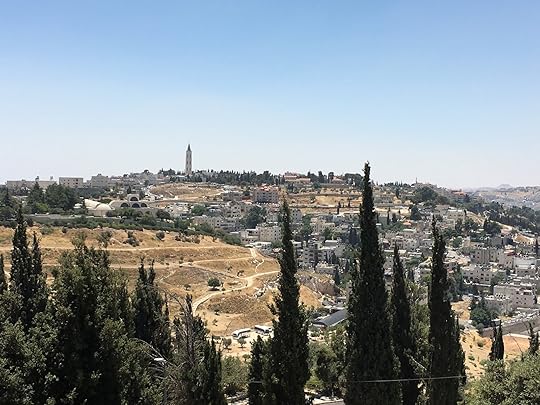 The view of Mount Scopus from the Mount of OlivesMount Scopus is the highest peak along the ridge that is also known as the Mount of Olives.
The view of Mount Scopus from the Mount of OlivesMount Scopus is the highest peak along the ridge that is also known as the Mount of Olives. Looking at JerusalemThe name of the peak means “watcher.” Since antiquity people have climbed the mountain to scope out what is occurring in Jerusalem.
Looking at JerusalemThe name of the peak means “watcher.” Since antiquity people have climbed the mountain to scope out what is occurring in Jerusalem.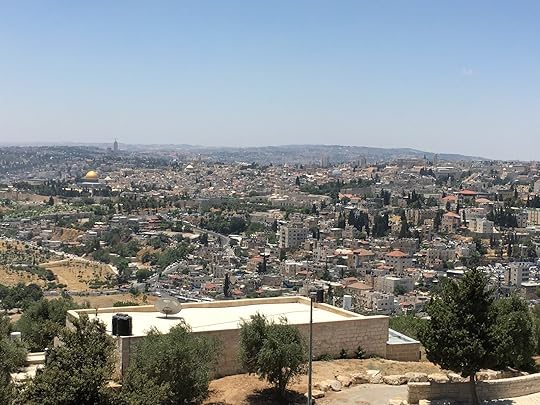 Looking at Jerusalem from Hebrew UniversityIn 1918, Zionist leaders laid a cornerstone as a promise to build a place of higher learning on top of Mount Scopus. The school opened in 1925.
Looking at Jerusalem from Hebrew UniversityIn 1918, Zionist leaders laid a cornerstone as a promise to build a place of higher learning on top of Mount Scopus. The school opened in 1925.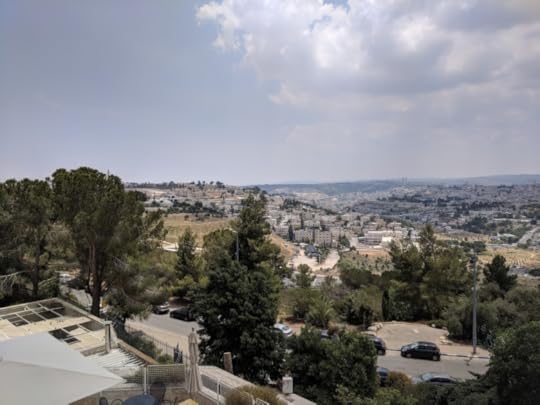 Looking down from Hebrew UniversityAfter Israel was created in 1948, the mountain became part of a United Nations zone of protection within Jordanian territory. At times Mount Scopus, with it’s school, was totally cut off from the outside. Men and women dedicated to the institution of higher learning on it’s peak protected the school by offering their continual presence.
Looking down from Hebrew UniversityAfter Israel was created in 1948, the mountain became part of a United Nations zone of protection within Jordanian territory. At times Mount Scopus, with it’s school, was totally cut off from the outside. Men and women dedicated to the institution of higher learning on it’s peak protected the school by offering their continual presence.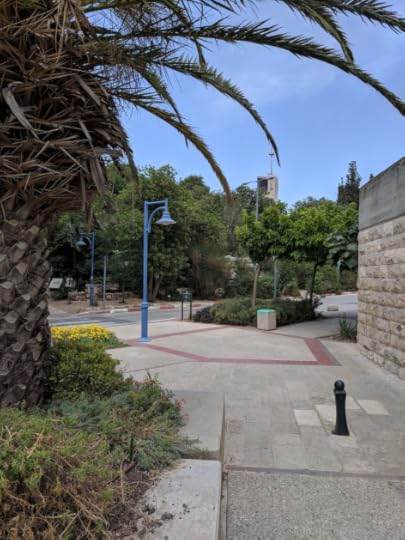 A Plaza at Hebrew UniversityWe took the bus up Mount Scopus for our visit to the University.
A Plaza at Hebrew UniversityWe took the bus up Mount Scopus for our visit to the University.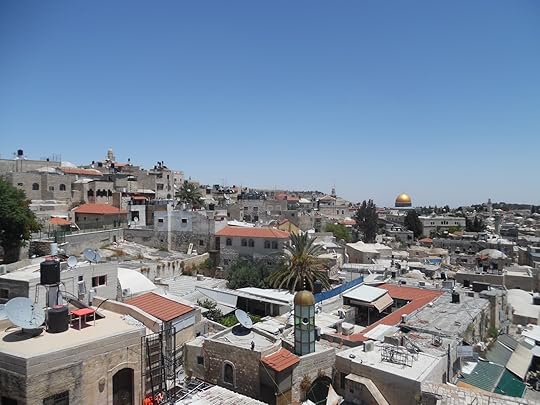 Looking up to Mount Scopus from the wall around JerusalemWhen we arrived on campus, we stepped out to one of the overlook plazas on the campus. The campus is large and an easy place to get lost. Various buildings are attached and dedicated to various disciplines. Other buildings are across open plazas, or on the eastern descent of the mountain.
Looking up to Mount Scopus from the wall around JerusalemWhen we arrived on campus, we stepped out to one of the overlook plazas on the campus. The campus is large and an easy place to get lost. Various buildings are attached and dedicated to various disciplines. Other buildings are across open plazas, or on the eastern descent of the mountain.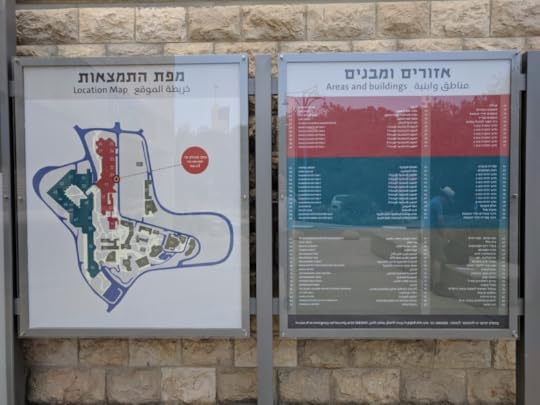 Map of Hebrew UniversityAfter taking pictures we walked to the east side of the mountain and visited The National Botanic Garden of Israel.
Map of Hebrew UniversityAfter taking pictures we walked to the east side of the mountain and visited The National Botanic Garden of Israel. 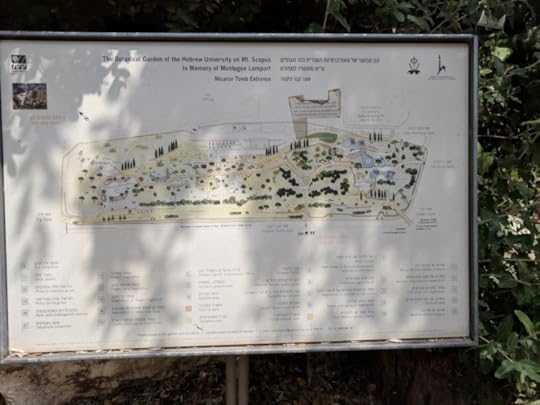 The Garden at Hebrew UniversityThis garden was started by one of the professors of Biology with the goal of planting and maintaining every plant native to the land of the Bible.
The Garden at Hebrew UniversityThis garden was started by one of the professors of Biology with the goal of planting and maintaining every plant native to the land of the Bible. 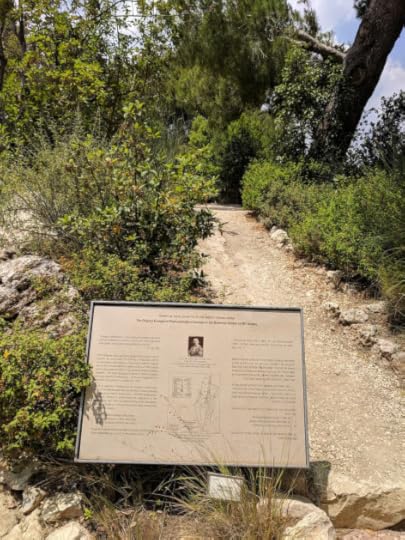 How the Garden StartedThe gardens are diverse, containing everything from water plants
How the Garden StartedThe gardens are diverse, containing everything from water plants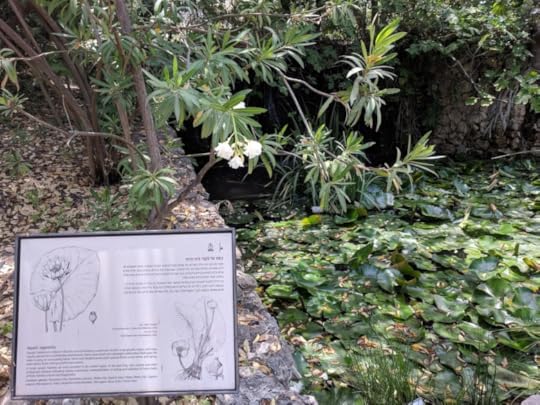 Water Plants at Hebrew University(look closely, can you count the frogs??)
Water Plants at Hebrew University(look closely, can you count the frogs??)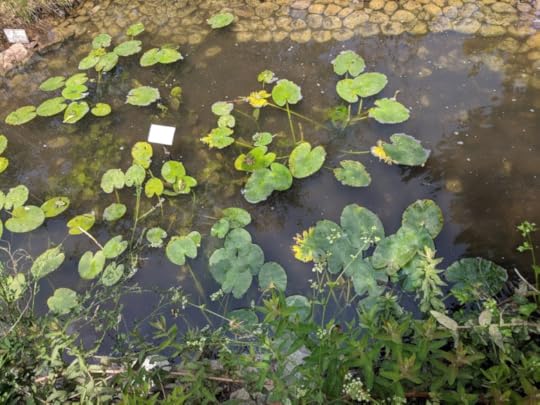 Frogs on the Lily PadTo plants of the Negev.
Frogs on the Lily PadTo plants of the Negev.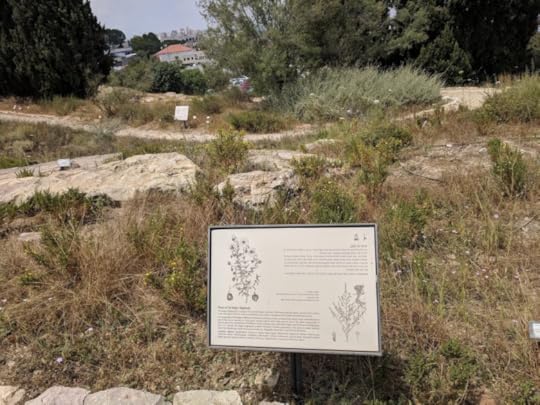 Plants of the NegevThe garden also contains tombs dating back to the times of the New Testament and before.
Plants of the NegevThe garden also contains tombs dating back to the times of the New Testament and before.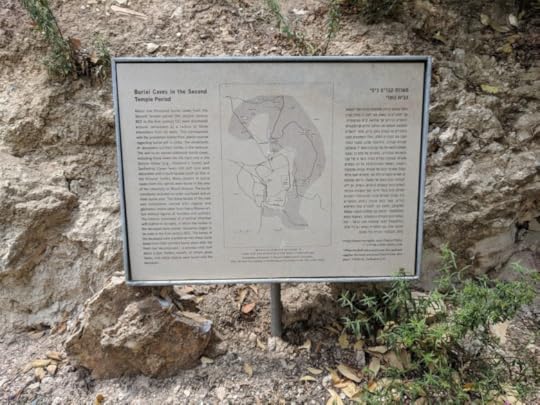 First Century Tombs around JerusalemA Jewish man named Nicanor of Alexandria, who donated the beautiful (Acts 3) bronze Eastern Gate of Herod’s Temple is buried in this graveyard.
First Century Tombs around JerusalemA Jewish man named Nicanor of Alexandria, who donated the beautiful (Acts 3) bronze Eastern Gate of Herod’s Temple is buried in this graveyard.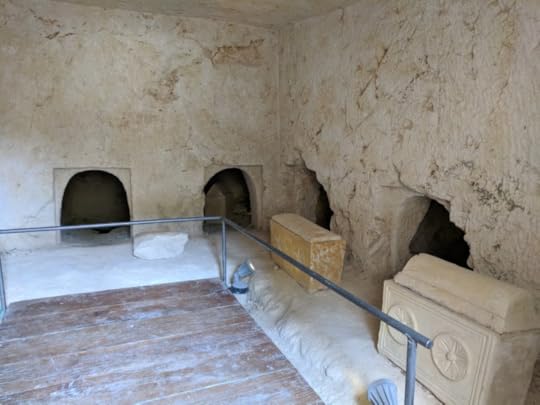 First Century Tombs and OsuaryThe gardens extend throughout the University,[image error]Plants on Mount ScopusWith Tabachnik Garden, a National Park, located below the University on the southern slopes of Mount Scopus.
First Century Tombs and OsuaryThe gardens extend throughout the University,[image error]Plants on Mount ScopusWith Tabachnik Garden, a National Park, located below the University on the southern slopes of Mount Scopus.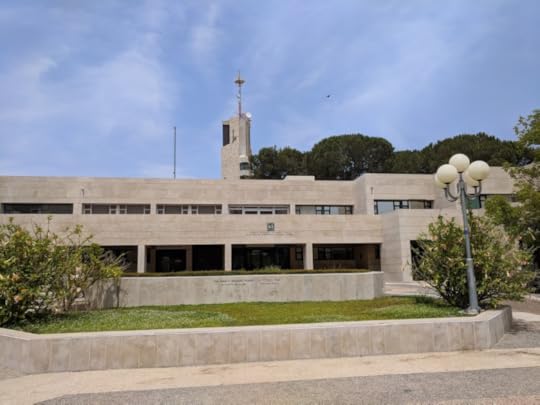 School of International StudiesWe walked the campus, and saw the International School, in the Frank Sinatra building.
School of International StudiesWe walked the campus, and saw the International School, in the Frank Sinatra building.
 Jerusalem from the top of Mount ScopusAt 2710 feet above sea level, Mount Scopus is the highest mountain near Jerusalem and it therefore offers a great view of the city.
Jerusalem from the top of Mount ScopusAt 2710 feet above sea level, Mount Scopus is the highest mountain near Jerusalem and it therefore offers a great view of the city. The view of Mount Scopus from the Mount of OlivesMount Scopus is the highest peak along the ridge that is also known as the Mount of Olives.
The view of Mount Scopus from the Mount of OlivesMount Scopus is the highest peak along the ridge that is also known as the Mount of Olives. Looking at JerusalemThe name of the peak means “watcher.” Since antiquity people have climbed the mountain to scope out what is occurring in Jerusalem.
Looking at JerusalemThe name of the peak means “watcher.” Since antiquity people have climbed the mountain to scope out what is occurring in Jerusalem. Looking at Jerusalem from Hebrew UniversityIn 1918, Zionist leaders laid a cornerstone as a promise to build a place of higher learning on top of Mount Scopus. The school opened in 1925.
Looking at Jerusalem from Hebrew UniversityIn 1918, Zionist leaders laid a cornerstone as a promise to build a place of higher learning on top of Mount Scopus. The school opened in 1925. Looking down from Hebrew UniversityAfter Israel was created in 1948, the mountain became part of a United Nations zone of protection within Jordanian territory. At times Mount Scopus, with it’s school, was totally cut off from the outside. Men and women dedicated to the institution of higher learning on it’s peak protected the school by offering their continual presence.
Looking down from Hebrew UniversityAfter Israel was created in 1948, the mountain became part of a United Nations zone of protection within Jordanian territory. At times Mount Scopus, with it’s school, was totally cut off from the outside. Men and women dedicated to the institution of higher learning on it’s peak protected the school by offering their continual presence. A Plaza at Hebrew UniversityWe took the bus up Mount Scopus for our visit to the University.
A Plaza at Hebrew UniversityWe took the bus up Mount Scopus for our visit to the University. Looking up to Mount Scopus from the wall around JerusalemWhen we arrived on campus, we stepped out to one of the overlook plazas on the campus. The campus is large and an easy place to get lost. Various buildings are attached and dedicated to various disciplines. Other buildings are across open plazas, or on the eastern descent of the mountain.
Looking up to Mount Scopus from the wall around JerusalemWhen we arrived on campus, we stepped out to one of the overlook plazas on the campus. The campus is large and an easy place to get lost. Various buildings are attached and dedicated to various disciplines. Other buildings are across open plazas, or on the eastern descent of the mountain. Map of Hebrew UniversityAfter taking pictures we walked to the east side of the mountain and visited The National Botanic Garden of Israel.
Map of Hebrew UniversityAfter taking pictures we walked to the east side of the mountain and visited The National Botanic Garden of Israel.  The Garden at Hebrew UniversityThis garden was started by one of the professors of Biology with the goal of planting and maintaining every plant native to the land of the Bible.
The Garden at Hebrew UniversityThis garden was started by one of the professors of Biology with the goal of planting and maintaining every plant native to the land of the Bible.  How the Garden StartedThe gardens are diverse, containing everything from water plants
How the Garden StartedThe gardens are diverse, containing everything from water plants Water Plants at Hebrew University(look closely, can you count the frogs??)
Water Plants at Hebrew University(look closely, can you count the frogs??) Frogs on the Lily PadTo plants of the Negev.
Frogs on the Lily PadTo plants of the Negev. Plants of the NegevThe garden also contains tombs dating back to the times of the New Testament and before.
Plants of the NegevThe garden also contains tombs dating back to the times of the New Testament and before. First Century Tombs around JerusalemA Jewish man named Nicanor of Alexandria, who donated the beautiful (Acts 3) bronze Eastern Gate of Herod’s Temple is buried in this graveyard.
First Century Tombs around JerusalemA Jewish man named Nicanor of Alexandria, who donated the beautiful (Acts 3) bronze Eastern Gate of Herod’s Temple is buried in this graveyard. First Century Tombs and OsuaryThe gardens extend throughout the University,[image error]Plants on Mount ScopusWith Tabachnik Garden, a National Park, located below the University on the southern slopes of Mount Scopus.
First Century Tombs and OsuaryThe gardens extend throughout the University,[image error]Plants on Mount ScopusWith Tabachnik Garden, a National Park, located below the University on the southern slopes of Mount Scopus. School of International StudiesWe walked the campus, and saw the International School, in the Frank Sinatra building.
School of International StudiesWe walked the campus, and saw the International School, in the Frank Sinatra building.
Published on June 06, 2018 10:49
June 4, 2018
A Morning Walk up the Mount of Olives
Today in Jerusalem I took advantage of the cool morning air to hike to the top of the Mount of Olives.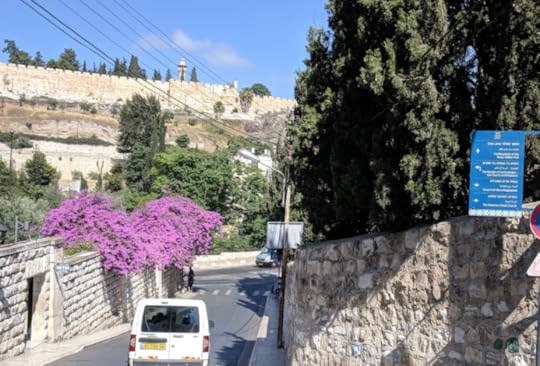 Looking up toward Temple Mount from the Mount of OlivesAfter a light Israeli breakfast my journey began by turning right out of the door at the Abraham Hostel.
Looking up toward Temple Mount from the Mount of OlivesAfter a light Israeli breakfast my journey began by turning right out of the door at the Abraham Hostel.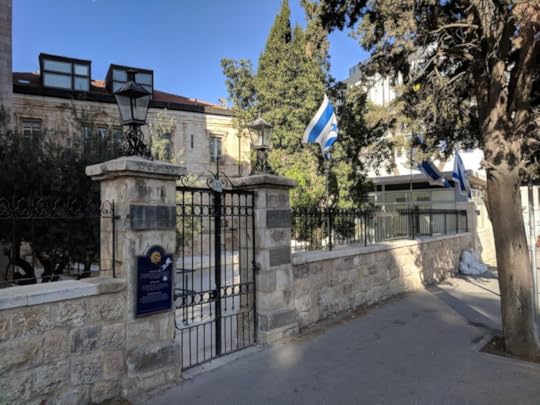 Rothschild Hospital in JerusalemI walked down HaNevi’im Street, or the street of the Prophets.
Rothschild Hospital in JerusalemI walked down HaNevi’im Street, or the street of the Prophets.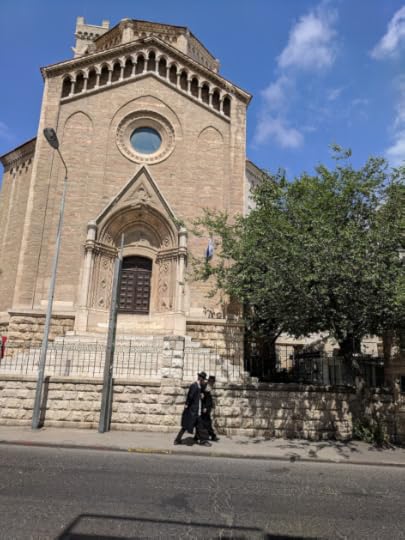 An Italian Hospital, now Israel Ministry of Education in JerusalemThere are many interesting old buildings from the British era and before.
An Italian Hospital, now Israel Ministry of Education in JerusalemThere are many interesting old buildings from the British era and before.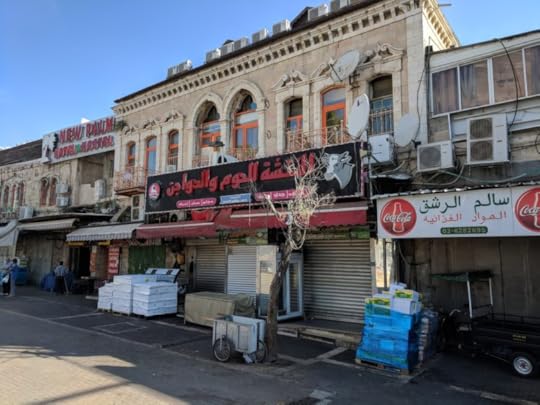 Shops near the Damascus GateI turned onto Sultan Suleiman Street, where I saw several markets selling fresh food.
Shops near the Damascus GateI turned onto Sultan Suleiman Street, where I saw several markets selling fresh food.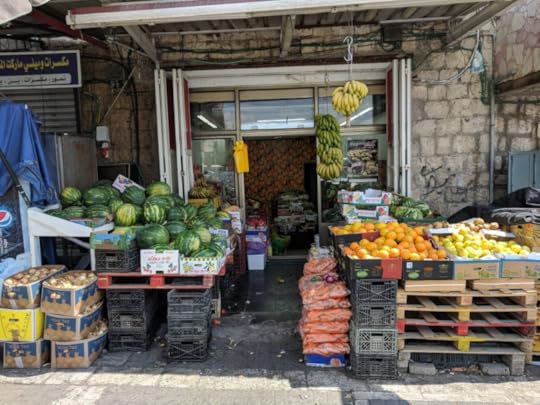 Small shop with fresh fruitSultan Suleiman is an Ottoman ruler who built the current walls of Jerusalem about 500 AD.
Small shop with fresh fruitSultan Suleiman is an Ottoman ruler who built the current walls of Jerusalem about 500 AD.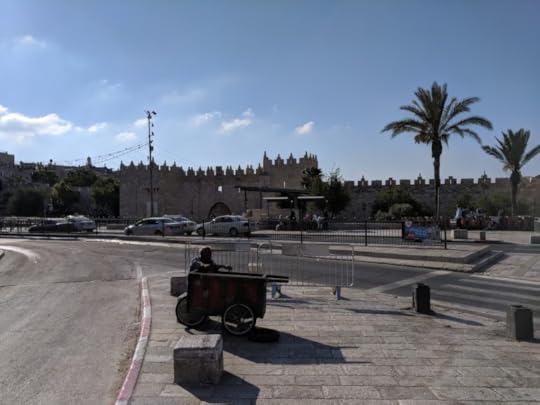 Man with cart near the Damascus GateI came up to the wall at the Damascus Gate,
Man with cart near the Damascus GateI came up to the wall at the Damascus Gate,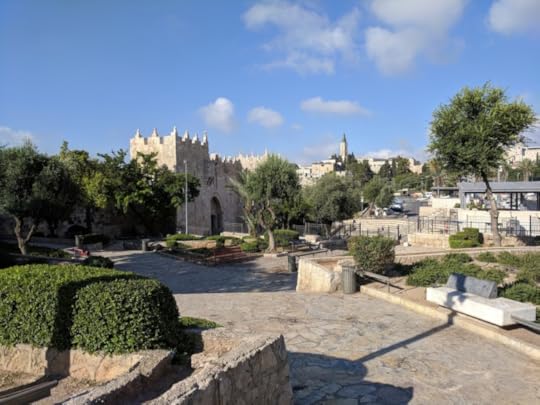 Approaching the Damascus GateWhere an old Roman gate can be seen below the entrance.
Approaching the Damascus GateWhere an old Roman gate can be seen below the entrance.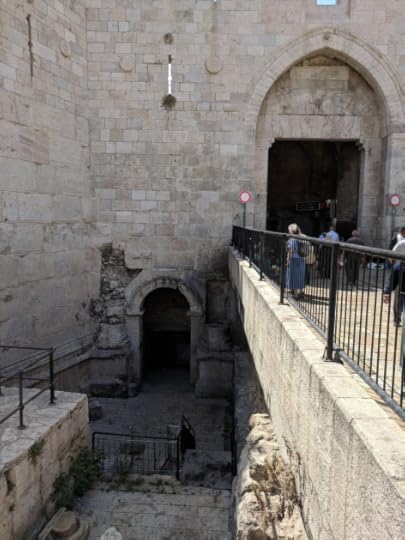 The Two Damascus GatesI walked through the Walls of Jerusalem National Park and passed Zedekiah’s Cave.
The Two Damascus GatesI walked through the Walls of Jerusalem National Park and passed Zedekiah’s Cave.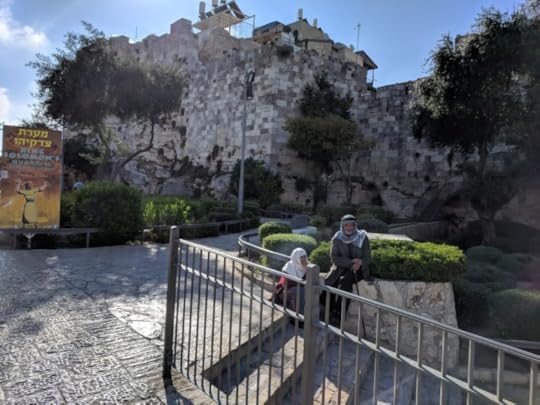 Zedekiah's CaveThe walls are built on high bedrock in this area.
Zedekiah's CaveThe walls are built on high bedrock in this area.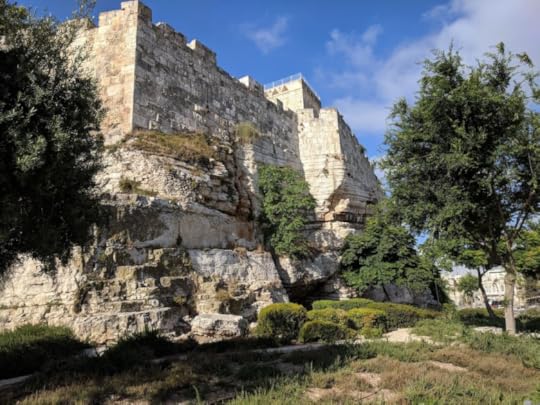 Walls of Jerusalem on BedrockVendors were setting up the market at Herod’s gate (Flower Gate) as I passed.
Walls of Jerusalem on BedrockVendors were setting up the market at Herod’s gate (Flower Gate) as I passed.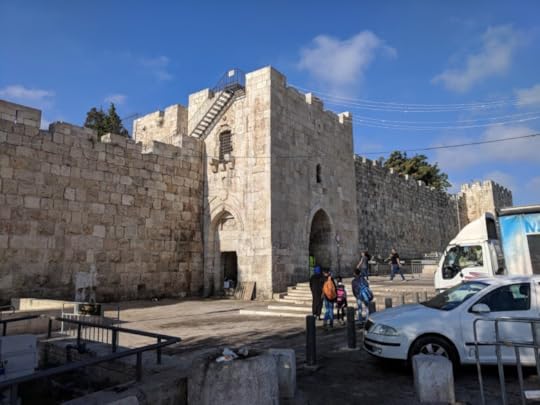 Herod's GateThen I took a walkway through an Islamic cemetery.
Herod's GateThen I took a walkway through an Islamic cemetery.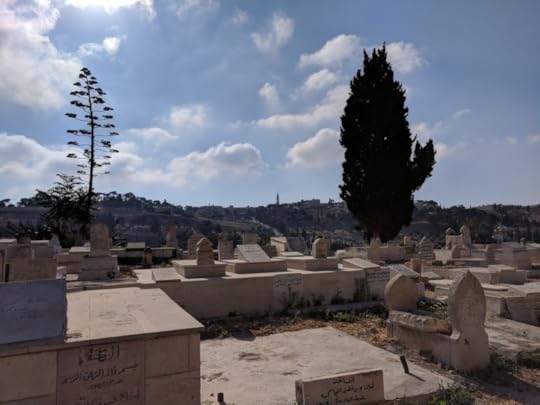 Mount of Olives from Islamic CemeteryI got a great view of Lion’s Gate from the cemetery which stood above the gate.
Mount of Olives from Islamic CemeteryI got a great view of Lion’s Gate from the cemetery which stood above the gate. Stephen Gate in JerusalemFrom there I went into the Kidron Valley,
Stephen Gate in JerusalemFrom there I went into the Kidron Valley,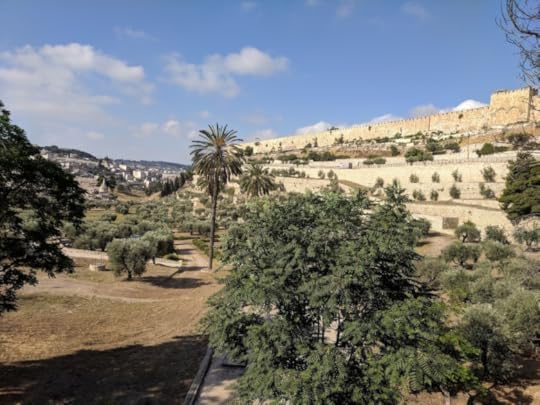 Kindron Valley, Absalom's Tomb in the valleyAnd passed the Church of St. Mary. There is a grotto here where Jesus prayed on the night he was arrested.
Kindron Valley, Absalom's Tomb in the valleyAnd passed the Church of St. Mary. There is a grotto here where Jesus prayed on the night he was arrested.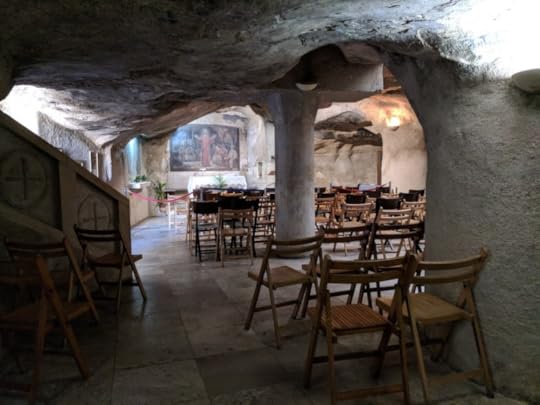 Grotto of the Virgin MaryAlso an Orthodox church, which is supposedly the place where the Virgin Mary was buried. This cave is quite ornate.
Grotto of the Virgin MaryAlso an Orthodox church, which is supposedly the place where the Virgin Mary was buried. This cave is quite ornate.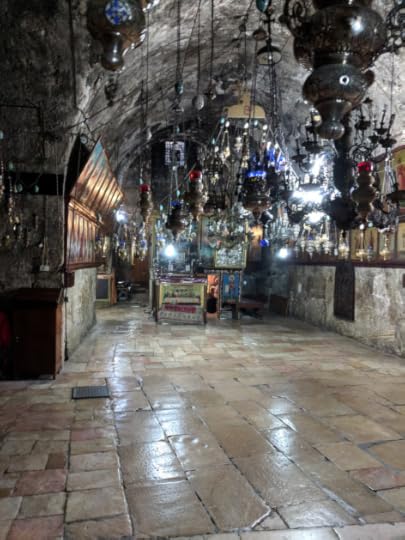 Tomb of the Virgin MaryThe Church of All Nations with its ancient Olive Trees is across the street.
Tomb of the Virgin MaryThe Church of All Nations with its ancient Olive Trees is across the street. Church of All Nations - Old Olive TreesI found a set of stairs and walked up.
Church of All Nations - Old Olive TreesI found a set of stairs and walked up.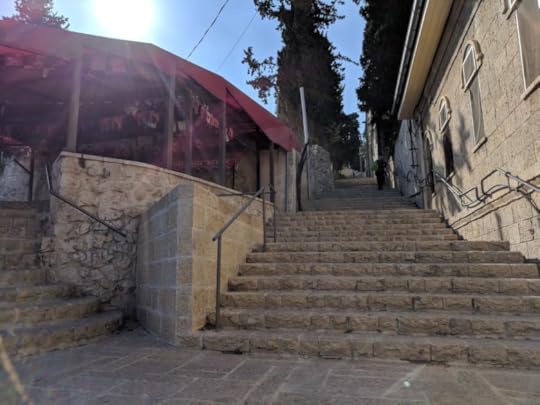 Stairs leading to top of Mount of OlivesThe walk afforded great views!
Stairs leading to top of Mount of OlivesThe walk afforded great views!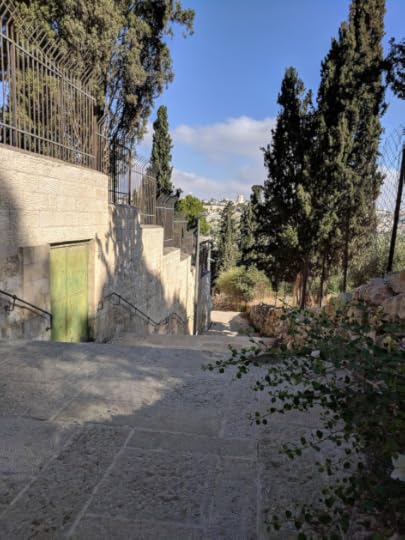 View of Jerusalem from Olivet's StepsThere was a trail through an Olive Grove where I could picture King David and Jesus walking as they traversed the Mount of Olives.
View of Jerusalem from Olivet's StepsThere was a trail through an Olive Grove where I could picture King David and Jesus walking as they traversed the Mount of Olives. Path through the Olive OrchardThe stairs were like a road with homes along the way.
Path through the Olive OrchardThe stairs were like a road with homes along the way.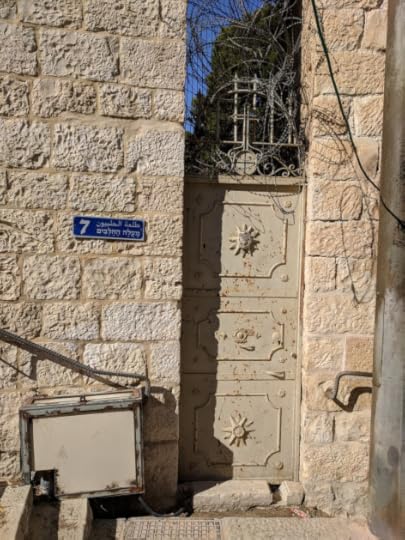 Doorway along the stepsAt the top I reached Pater Noster Church, which is reported to be a place where Jesus taught. This might have been the place he prayed on his last night.
Doorway along the stepsAt the top I reached Pater Noster Church, which is reported to be a place where Jesus taught. This might have been the place he prayed on his last night.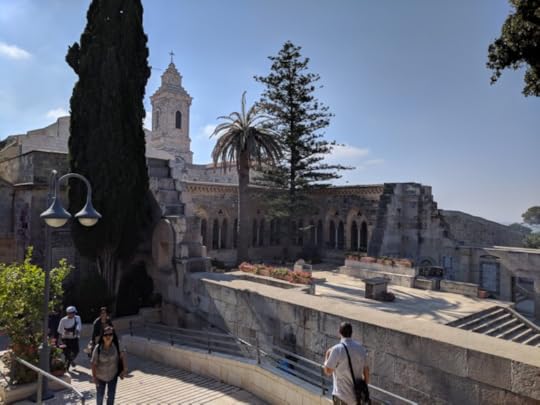 Pater Noster Church from EntranceThere was a 10 shekel charge to get in, and my wallet was back at the Hostel, so I looked from the entrance, and decided to come back at some time.
Pater Noster Church from EntranceThere was a 10 shekel charge to get in, and my wallet was back at the Hostel, so I looked from the entrance, and decided to come back at some time.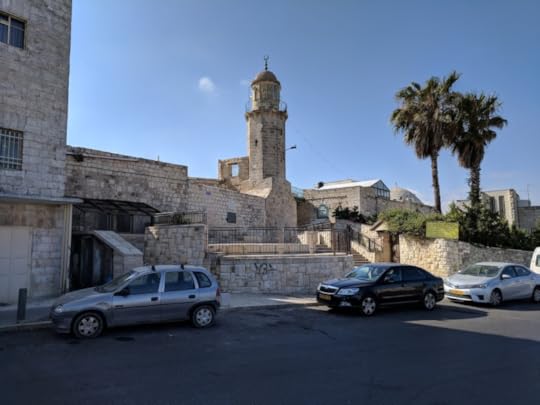 Mosque of the AscensionI walked over to the Church of the Ascension.
Mosque of the AscensionI walked over to the Church of the Ascension.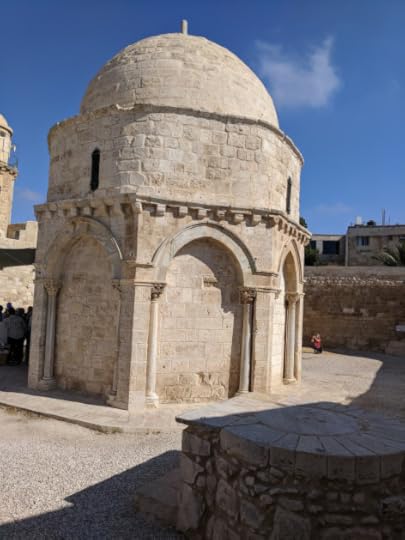 Dome of the AscensionI listened to a guide inside,
Dome of the AscensionI listened to a guide inside,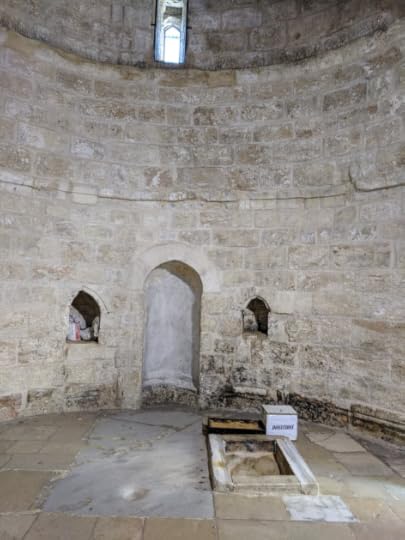 The Place where Jesus ascended to heaven - Acts 1:8Who explained the footprint of Jesus left at this spot.
The Place where Jesus ascended to heaven - Acts 1:8Who explained the footprint of Jesus left at this spot.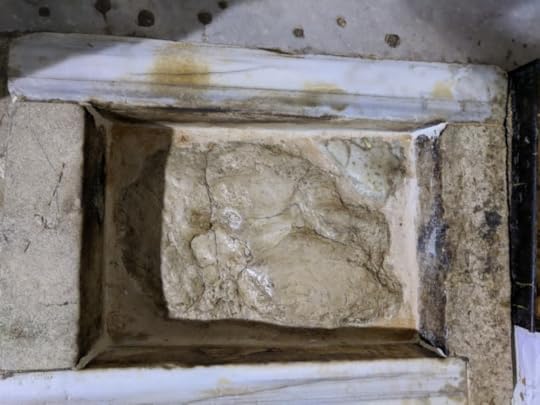 Heel mark can be seen on the left
Heel mark can be seen on the left
It was an interesting walk. I saw many of the tings I wrote about in my book - Israel: Stories for Your Journey. (If you have not bought one yet, now is the time to click the link and order your copy.)
 Looking up toward Temple Mount from the Mount of OlivesAfter a light Israeli breakfast my journey began by turning right out of the door at the Abraham Hostel.
Looking up toward Temple Mount from the Mount of OlivesAfter a light Israeli breakfast my journey began by turning right out of the door at the Abraham Hostel. Rothschild Hospital in JerusalemI walked down HaNevi’im Street, or the street of the Prophets.
Rothschild Hospital in JerusalemI walked down HaNevi’im Street, or the street of the Prophets. An Italian Hospital, now Israel Ministry of Education in JerusalemThere are many interesting old buildings from the British era and before.
An Italian Hospital, now Israel Ministry of Education in JerusalemThere are many interesting old buildings from the British era and before. Shops near the Damascus GateI turned onto Sultan Suleiman Street, where I saw several markets selling fresh food.
Shops near the Damascus GateI turned onto Sultan Suleiman Street, where I saw several markets selling fresh food. Small shop with fresh fruitSultan Suleiman is an Ottoman ruler who built the current walls of Jerusalem about 500 AD.
Small shop with fresh fruitSultan Suleiman is an Ottoman ruler who built the current walls of Jerusalem about 500 AD. Man with cart near the Damascus GateI came up to the wall at the Damascus Gate,
Man with cart near the Damascus GateI came up to the wall at the Damascus Gate, Approaching the Damascus GateWhere an old Roman gate can be seen below the entrance.
Approaching the Damascus GateWhere an old Roman gate can be seen below the entrance. The Two Damascus GatesI walked through the Walls of Jerusalem National Park and passed Zedekiah’s Cave.
The Two Damascus GatesI walked through the Walls of Jerusalem National Park and passed Zedekiah’s Cave. Zedekiah's CaveThe walls are built on high bedrock in this area.
Zedekiah's CaveThe walls are built on high bedrock in this area. Walls of Jerusalem on BedrockVendors were setting up the market at Herod’s gate (Flower Gate) as I passed.
Walls of Jerusalem on BedrockVendors were setting up the market at Herod’s gate (Flower Gate) as I passed. Herod's GateThen I took a walkway through an Islamic cemetery.
Herod's GateThen I took a walkway through an Islamic cemetery. Mount of Olives from Islamic CemeteryI got a great view of Lion’s Gate from the cemetery which stood above the gate.
Mount of Olives from Islamic CemeteryI got a great view of Lion’s Gate from the cemetery which stood above the gate. Stephen Gate in JerusalemFrom there I went into the Kidron Valley,
Stephen Gate in JerusalemFrom there I went into the Kidron Valley, Kindron Valley, Absalom's Tomb in the valleyAnd passed the Church of St. Mary. There is a grotto here where Jesus prayed on the night he was arrested.
Kindron Valley, Absalom's Tomb in the valleyAnd passed the Church of St. Mary. There is a grotto here where Jesus prayed on the night he was arrested. Grotto of the Virgin MaryAlso an Orthodox church, which is supposedly the place where the Virgin Mary was buried. This cave is quite ornate.
Grotto of the Virgin MaryAlso an Orthodox church, which is supposedly the place where the Virgin Mary was buried. This cave is quite ornate. Tomb of the Virgin MaryThe Church of All Nations with its ancient Olive Trees is across the street.
Tomb of the Virgin MaryThe Church of All Nations with its ancient Olive Trees is across the street. Church of All Nations - Old Olive TreesI found a set of stairs and walked up.
Church of All Nations - Old Olive TreesI found a set of stairs and walked up. Stairs leading to top of Mount of OlivesThe walk afforded great views!
Stairs leading to top of Mount of OlivesThe walk afforded great views! View of Jerusalem from Olivet's StepsThere was a trail through an Olive Grove where I could picture King David and Jesus walking as they traversed the Mount of Olives.
View of Jerusalem from Olivet's StepsThere was a trail through an Olive Grove where I could picture King David and Jesus walking as they traversed the Mount of Olives. Path through the Olive OrchardThe stairs were like a road with homes along the way.
Path through the Olive OrchardThe stairs were like a road with homes along the way. Doorway along the stepsAt the top I reached Pater Noster Church, which is reported to be a place where Jesus taught. This might have been the place he prayed on his last night.
Doorway along the stepsAt the top I reached Pater Noster Church, which is reported to be a place where Jesus taught. This might have been the place he prayed on his last night. Pater Noster Church from EntranceThere was a 10 shekel charge to get in, and my wallet was back at the Hostel, so I looked from the entrance, and decided to come back at some time.
Pater Noster Church from EntranceThere was a 10 shekel charge to get in, and my wallet was back at the Hostel, so I looked from the entrance, and decided to come back at some time. Mosque of the AscensionI walked over to the Church of the Ascension.
Mosque of the AscensionI walked over to the Church of the Ascension. Dome of the AscensionI listened to a guide inside,
Dome of the AscensionI listened to a guide inside, The Place where Jesus ascended to heaven - Acts 1:8Who explained the footprint of Jesus left at this spot.
The Place where Jesus ascended to heaven - Acts 1:8Who explained the footprint of Jesus left at this spot. Heel mark can be seen on the left
Heel mark can be seen on the leftIt was an interesting walk. I saw many of the tings I wrote about in my book - Israel: Stories for Your Journey. (If you have not bought one yet, now is the time to click the link and order your copy.)
Published on June 04, 2018 20:55
June 3, 2018
Climbing Mount Arbel
The mountain of Galilee called Arbel is an amazing place. The mountain, at just under 600’ above sea level on first hearing is a bit anemic, but normal statistical facts are just one way of looking at the mountain. The more impressive number comes as one begins to understand that Mount Arbel overlooks the Sea of Galilee, which is currently 700’ below sea level. This means a climb up the mountain (and the view off the mountain) is about 1,300 feet. Both the view and the climb are worth the effort it takes to reach the top.
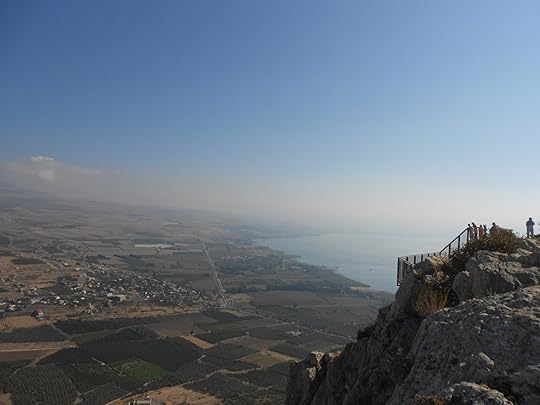 The northern view from Mt. ArbelAn ascent up Mount Arbel begins at a trail head between Magdala and Migdal near the intersection of highways 90 and 807. We got off of a bus, but there is probably also a place for cars. The beginning of the trail is a moderate, but continual ascent with very few stairs.
The northern view from Mt. ArbelAn ascent up Mount Arbel begins at a trail head between Magdala and Migdal near the intersection of highways 90 and 807. We got off of a bus, but there is probably also a place for cars. The beginning of the trail is a moderate, but continual ascent with very few stairs.
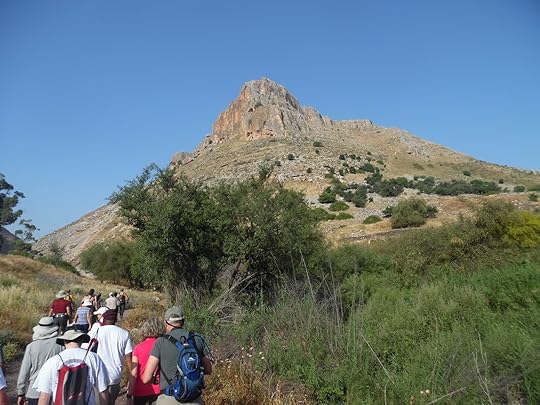 Mount Nital next to Mount ArbelThe trail enters the national park across a cattle guard in an area where bovine are grazing. One web posting said, “If you don’t bother them, they won’t bother you.” The cattle add to the scenic appeal along with wild flowers and various types of plants along the trail.
Mount Nital next to Mount ArbelThe trail enters the national park across a cattle guard in an area where bovine are grazing. One web posting said, “If you don’t bother them, they won’t bother you.” The cattle add to the scenic appeal along with wild flowers and various types of plants along the trail.
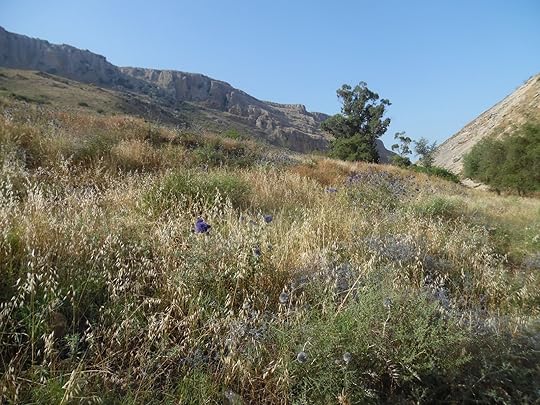 Spring flowers on the trailThe trail ascends between two peaks: Mount Arbel and Mount Nitai (named after a Rabbi of the 2nd Century BC, who is quoted in the Mishnah as saying, “Keep your distance from bad neighbors, ally yourself not with the wicked and do not abandon hope when faced with calamity.”) Notice as you hike the caves on both mountains.
Spring flowers on the trailThe trail ascends between two peaks: Mount Arbel and Mount Nitai (named after a Rabbi of the 2nd Century BC, who is quoted in the Mishnah as saying, “Keep your distance from bad neighbors, ally yourself not with the wicked and do not abandon hope when faced with calamity.”) Notice as you hike the caves on both mountains.
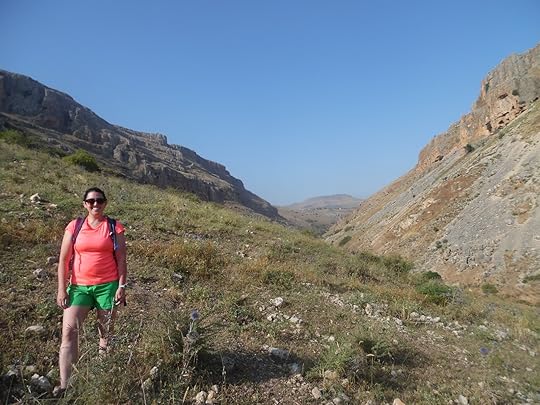 The Horns of Hattin seen from our trailRising between the two mountains the hiker will notice the Horns of Hattin, an important battle site where the European Crusaders faced a humiliating defeat to Ayyubid sultan Salah ad-Din, (AKA, Saladin). The actual peak is an old volcano crater.
The Horns of Hattin seen from our trailRising between the two mountains the hiker will notice the Horns of Hattin, an important battle site where the European Crusaders faced a humiliating defeat to Ayyubid sultan Salah ad-Din, (AKA, Saladin). The actual peak is an old volcano crater.
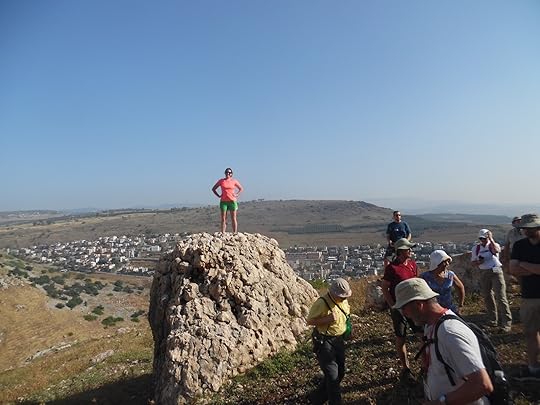 A stop at the tall rockThe trail ascends to an area with rock outcroppings, which provide seating so the view below can be enjoyed. This is a good time to take a break, because the trail will become steeper beyond this point, and most who take the trail will be ready for a rest. The villages of Migdal, Hamaam, and Ginosar can be seen below. The rest can be short, for the view gets better as one ascends.
A stop at the tall rockThe trail ascends to an area with rock outcroppings, which provide seating so the view below can be enjoyed. This is a good time to take a break, because the trail will become steeper beyond this point, and most who take the trail will be ready for a rest. The villages of Migdal, Hamaam, and Ginosar can be seen below. The rest can be short, for the view gets better as one ascends.
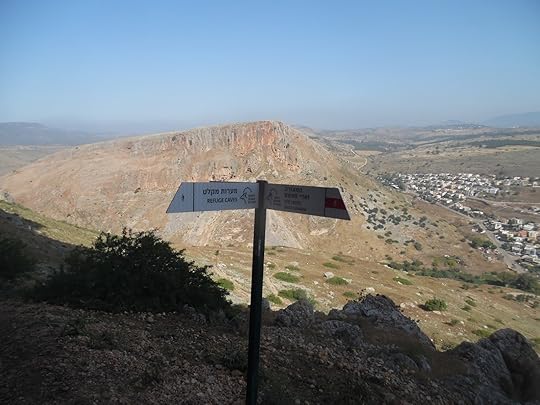 Trail signs ... and decisionsThe next stop, along an ascent and several steps is at a set of trail markers. At this point it is time to explore some of the nearby caves and to take pictures of the caves on Mount Arbel and Mount Nitai. When it comes time to move on, a choice must be made between two trails. The trail to the left ascends to the top of Arbel with scenic views of the Sea of Galilee. The trail to the right goes through areas of caves towards the visitor center, away from the lake. Both are very beautiful in their own way. The trail along the caves is more difficult.
Trail signs ... and decisionsThe next stop, along an ascent and several steps is at a set of trail markers. At this point it is time to explore some of the nearby caves and to take pictures of the caves on Mount Arbel and Mount Nitai. When it comes time to move on, a choice must be made between two trails. The trail to the left ascends to the top of Arbel with scenic views of the Sea of Galilee. The trail to the right goes through areas of caves towards the visitor center, away from the lake. Both are very beautiful in their own way. The trail along the caves is more difficult.
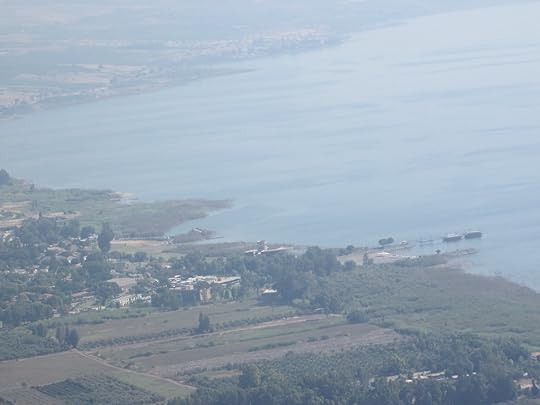 The Sea of Galilee from Mt. ArbelThe trail to the left crosses many rock outcroppings, contains teps and metal handholds. It ascends between Kinneret and Caro lookouts. The beauty is outstanding. There are many places to sit and enjoy the views, so climbers should not be in a rush to get to the top.
The Sea of Galilee from Mt. ArbelThe trail to the left crosses many rock outcroppings, contains teps and metal handholds. It ascends between Kinneret and Caro lookouts. The beauty is outstanding. There are many places to sit and enjoy the views, so climbers should not be in a rush to get to the top.
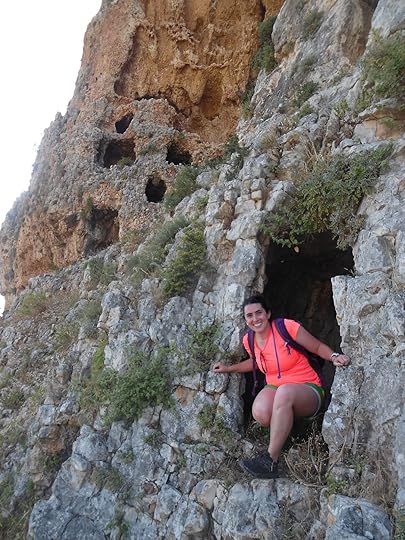 A Cave Dwelling on Mt. ArbelThe cave route gives the climber opportunities to visit the Ottoman Fortress and the caves of Refuge. The caves are interesting because they provided safety zones in times of battle. They were large enough for families and many men to live within, but the arrival pathway was very narrow. Attacking armies were required to travel single file, and could easily be pushed off the mountain upon reaching cave entrances.
A Cave Dwelling on Mt. ArbelThe cave route gives the climber opportunities to visit the Ottoman Fortress and the caves of Refuge. The caves are interesting because they provided safety zones in times of battle. They were large enough for families and many men to live within, but the arrival pathway was very narrow. Attacking armies were required to travel single file, and could easily be pushed off the mountain upon reaching cave entrances.
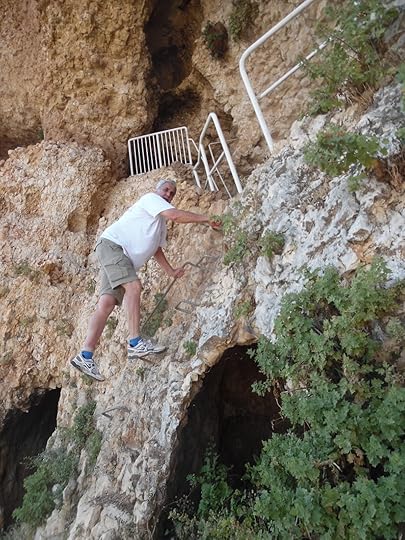 Caves on top of caves, a high-rise complexThe caves became hideouts in 161 BCE, when Seleucid commander Bacchides came to fight Judah Maccabee. They were used again in 25 BCE when the people of Galilee resisted a new governor named Herod the Great. They found use again during the great revolts of 70 and 132 AD.
Caves on top of caves, a high-rise complexThe caves became hideouts in 161 BCE, when Seleucid commander Bacchides came to fight Judah Maccabee. They were used again in 25 BCE when the people of Galilee resisted a new governor named Herod the Great. They found use again during the great revolts of 70 and 132 AD.
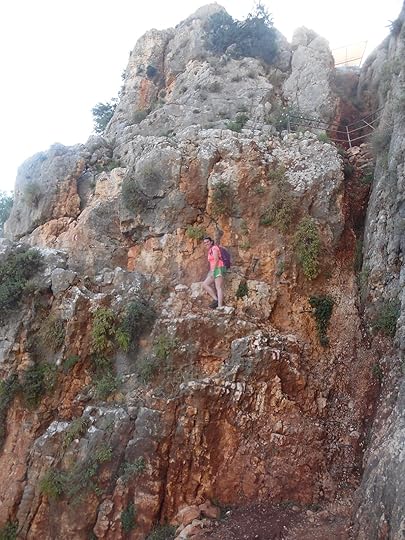 The steep ascent at the topIt could be said that the modern elevator was invented at Arbella. During the revolt of 37 BCE, Governor Herod would not tolerate any resistance, and required his generals to find a way of rooting out the rebels. They finally created a box car which could be lowered from the top of the cliff down to the caves. The car afforded safety railing which prevented soldiers from being shoved off the cliffs.
The steep ascent at the topIt could be said that the modern elevator was invented at Arbella. During the revolt of 37 BCE, Governor Herod would not tolerate any resistance, and required his generals to find a way of rooting out the rebels. They finally created a box car which could be lowered from the top of the cliff down to the caves. The car afforded safety railing which prevented soldiers from being shoved off the cliffs.
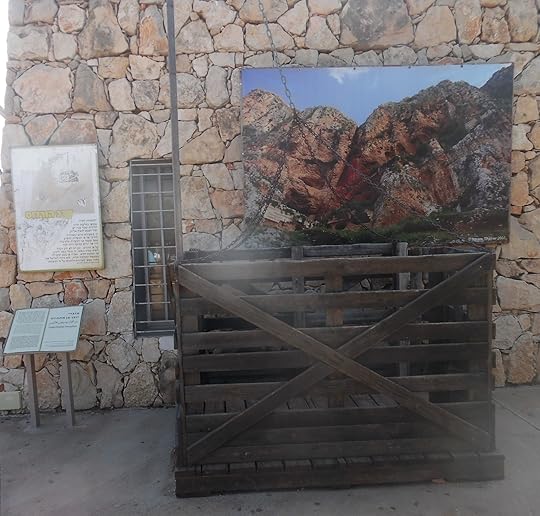 Reconstructed elevator from 37 BCE
Reconstructed elevator from 37 BCE
Several Jewish communities existed atop Mount Arbel. Jesus visited the mountain often with his disciples, and it is possible the transfiguration took place at this site.
 The northern view from Mt. ArbelAn ascent up Mount Arbel begins at a trail head between Magdala and Migdal near the intersection of highways 90 and 807. We got off of a bus, but there is probably also a place for cars. The beginning of the trail is a moderate, but continual ascent with very few stairs.
The northern view from Mt. ArbelAn ascent up Mount Arbel begins at a trail head between Magdala and Migdal near the intersection of highways 90 and 807. We got off of a bus, but there is probably also a place for cars. The beginning of the trail is a moderate, but continual ascent with very few stairs. Mount Nital next to Mount ArbelThe trail enters the national park across a cattle guard in an area where bovine are grazing. One web posting said, “If you don’t bother them, they won’t bother you.” The cattle add to the scenic appeal along with wild flowers and various types of plants along the trail.
Mount Nital next to Mount ArbelThe trail enters the national park across a cattle guard in an area where bovine are grazing. One web posting said, “If you don’t bother them, they won’t bother you.” The cattle add to the scenic appeal along with wild flowers and various types of plants along the trail. Spring flowers on the trailThe trail ascends between two peaks: Mount Arbel and Mount Nitai (named after a Rabbi of the 2nd Century BC, who is quoted in the Mishnah as saying, “Keep your distance from bad neighbors, ally yourself not with the wicked and do not abandon hope when faced with calamity.”) Notice as you hike the caves on both mountains.
Spring flowers on the trailThe trail ascends between two peaks: Mount Arbel and Mount Nitai (named after a Rabbi of the 2nd Century BC, who is quoted in the Mishnah as saying, “Keep your distance from bad neighbors, ally yourself not with the wicked and do not abandon hope when faced with calamity.”) Notice as you hike the caves on both mountains. The Horns of Hattin seen from our trailRising between the two mountains the hiker will notice the Horns of Hattin, an important battle site where the European Crusaders faced a humiliating defeat to Ayyubid sultan Salah ad-Din, (AKA, Saladin). The actual peak is an old volcano crater.
The Horns of Hattin seen from our trailRising between the two mountains the hiker will notice the Horns of Hattin, an important battle site where the European Crusaders faced a humiliating defeat to Ayyubid sultan Salah ad-Din, (AKA, Saladin). The actual peak is an old volcano crater. A stop at the tall rockThe trail ascends to an area with rock outcroppings, which provide seating so the view below can be enjoyed. This is a good time to take a break, because the trail will become steeper beyond this point, and most who take the trail will be ready for a rest. The villages of Migdal, Hamaam, and Ginosar can be seen below. The rest can be short, for the view gets better as one ascends.
A stop at the tall rockThe trail ascends to an area with rock outcroppings, which provide seating so the view below can be enjoyed. This is a good time to take a break, because the trail will become steeper beyond this point, and most who take the trail will be ready for a rest. The villages of Migdal, Hamaam, and Ginosar can be seen below. The rest can be short, for the view gets better as one ascends. Trail signs ... and decisionsThe next stop, along an ascent and several steps is at a set of trail markers. At this point it is time to explore some of the nearby caves and to take pictures of the caves on Mount Arbel and Mount Nitai. When it comes time to move on, a choice must be made between two trails. The trail to the left ascends to the top of Arbel with scenic views of the Sea of Galilee. The trail to the right goes through areas of caves towards the visitor center, away from the lake. Both are very beautiful in their own way. The trail along the caves is more difficult.
Trail signs ... and decisionsThe next stop, along an ascent and several steps is at a set of trail markers. At this point it is time to explore some of the nearby caves and to take pictures of the caves on Mount Arbel and Mount Nitai. When it comes time to move on, a choice must be made between two trails. The trail to the left ascends to the top of Arbel with scenic views of the Sea of Galilee. The trail to the right goes through areas of caves towards the visitor center, away from the lake. Both are very beautiful in their own way. The trail along the caves is more difficult. The Sea of Galilee from Mt. ArbelThe trail to the left crosses many rock outcroppings, contains teps and metal handholds. It ascends between Kinneret and Caro lookouts. The beauty is outstanding. There are many places to sit and enjoy the views, so climbers should not be in a rush to get to the top.
The Sea of Galilee from Mt. ArbelThe trail to the left crosses many rock outcroppings, contains teps and metal handholds. It ascends between Kinneret and Caro lookouts. The beauty is outstanding. There are many places to sit and enjoy the views, so climbers should not be in a rush to get to the top. A Cave Dwelling on Mt. ArbelThe cave route gives the climber opportunities to visit the Ottoman Fortress and the caves of Refuge. The caves are interesting because they provided safety zones in times of battle. They were large enough for families and many men to live within, but the arrival pathway was very narrow. Attacking armies were required to travel single file, and could easily be pushed off the mountain upon reaching cave entrances.
A Cave Dwelling on Mt. ArbelThe cave route gives the climber opportunities to visit the Ottoman Fortress and the caves of Refuge. The caves are interesting because they provided safety zones in times of battle. They were large enough for families and many men to live within, but the arrival pathway was very narrow. Attacking armies were required to travel single file, and could easily be pushed off the mountain upon reaching cave entrances. Caves on top of caves, a high-rise complexThe caves became hideouts in 161 BCE, when Seleucid commander Bacchides came to fight Judah Maccabee. They were used again in 25 BCE when the people of Galilee resisted a new governor named Herod the Great. They found use again during the great revolts of 70 and 132 AD.
Caves on top of caves, a high-rise complexThe caves became hideouts in 161 BCE, when Seleucid commander Bacchides came to fight Judah Maccabee. They were used again in 25 BCE when the people of Galilee resisted a new governor named Herod the Great. They found use again during the great revolts of 70 and 132 AD.  The steep ascent at the topIt could be said that the modern elevator was invented at Arbella. During the revolt of 37 BCE, Governor Herod would not tolerate any resistance, and required his generals to find a way of rooting out the rebels. They finally created a box car which could be lowered from the top of the cliff down to the caves. The car afforded safety railing which prevented soldiers from being shoved off the cliffs.
The steep ascent at the topIt could be said that the modern elevator was invented at Arbella. During the revolt of 37 BCE, Governor Herod would not tolerate any resistance, and required his generals to find a way of rooting out the rebels. They finally created a box car which could be lowered from the top of the cliff down to the caves. The car afforded safety railing which prevented soldiers from being shoved off the cliffs. Reconstructed elevator from 37 BCE
Reconstructed elevator from 37 BCESeveral Jewish communities existed atop Mount Arbel. Jesus visited the mountain often with his disciples, and it is possible the transfiguration took place at this site.
Published on June 03, 2018 00:09
June 1, 2018
Archaeological Digs
In the past week I have participated in two archaeological projects. 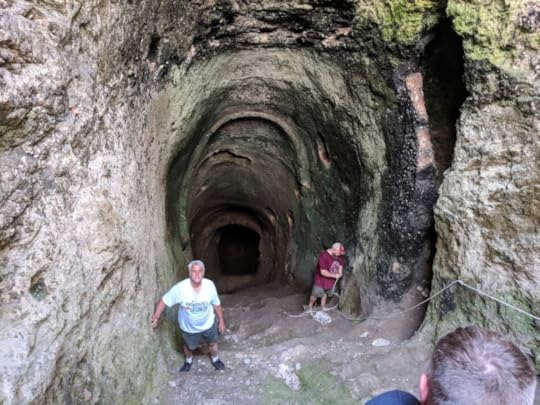 The Water Project at Tel GezerThe first was at Tel Gezer, where I was asked to clean the steps leading down into what is known as the water project.
The Water Project at Tel GezerThe first was at Tel Gezer, where I was asked to clean the steps leading down into what is known as the water project.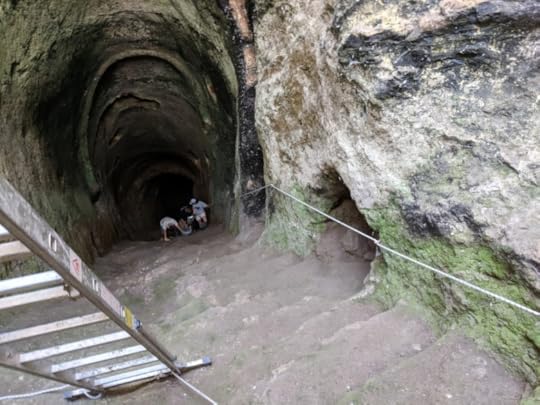 Cleaning the steps going into the earthThe steps, which are over 4,000 years old are made of soft limestone, and chip easily. The work involved careful brushing or lifting dirt with a mini mattock to remove all but surface level dirt, or to reveal the limestone step.
Cleaning the steps going into the earthThe steps, which are over 4,000 years old are made of soft limestone, and chip easily. The work involved careful brushing or lifting dirt with a mini mattock to remove all but surface level dirt, or to reveal the limestone step.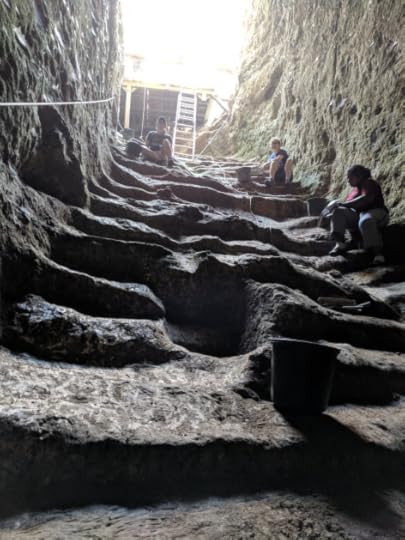 Looking up the steps into the cityThe second project was at the first century Arches Reservoir at Sippori.
Looking up the steps into the cityThe second project was at the first century Arches Reservoir at Sippori. Information about Arches ReservoirsOur project at Tsippori began with trash removal and then sweeping surface areas which had been recently excavated in order to obtain archaeological photographs.
Information about Arches ReservoirsOur project at Tsippori began with trash removal and then sweeping surface areas which had been recently excavated in order to obtain archaeological photographs. 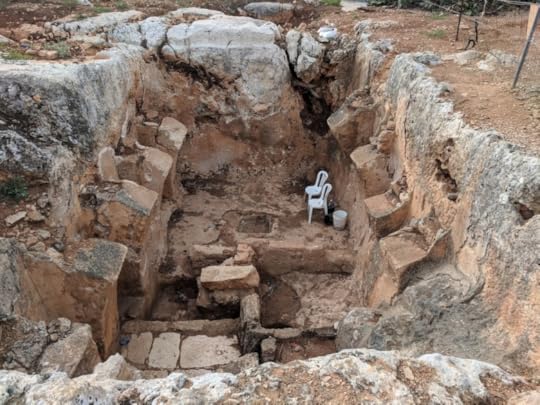 Looking into the Cistern when we arrivedThese pictures were taken in the early morning to lessen shadows created when the sun is high in the sky.
Looking into the Cistern when we arrivedThese pictures were taken in the early morning to lessen shadows created when the sun is high in the sky.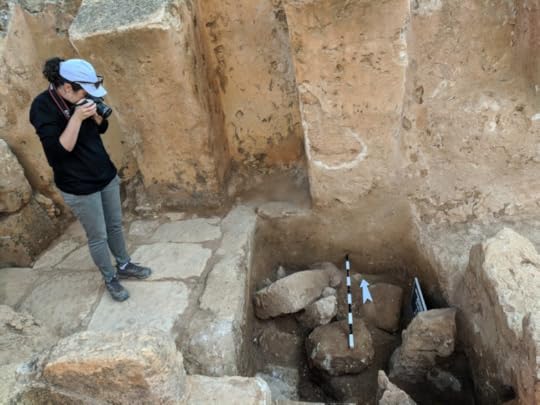 Archaeological PhotographyAfter the pictures were taken, a tarp was spread and tied over the Arches Reservoir to provide shade as we worked.
Archaeological PhotographyAfter the pictures were taken, a tarp was spread and tied over the Arches Reservoir to provide shade as we worked.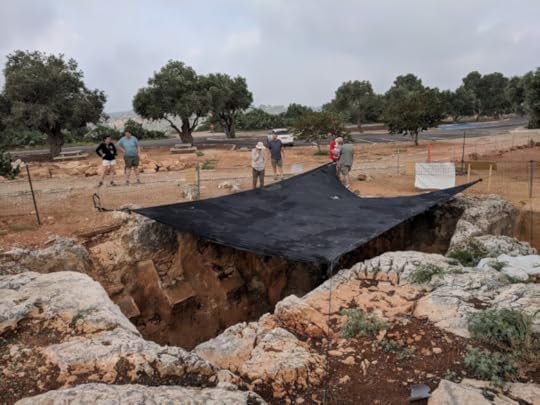 Spreading a tarp for the workersI was asked to remove dirt from a basin in the southern room of the central section of the former cistern (tank which was built for holding the community’s water).
Spreading a tarp for the workersI was asked to remove dirt from a basin in the southern room of the central section of the former cistern (tank which was built for holding the community’s water).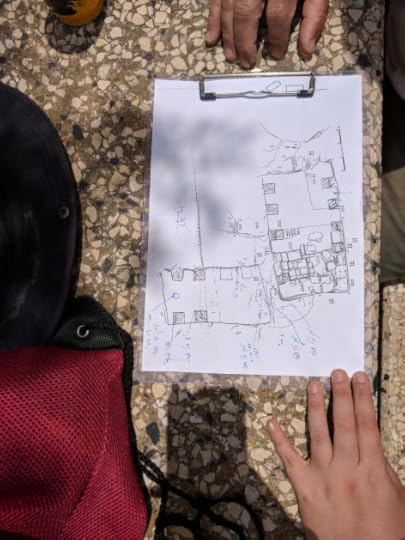 Two Cisterns, our dig is to the leftIt is thought that water was brought through channels (or aqueducts) from springs along the ridge of the Nazareth Mountains. When the Arches Reservoirs were first built in the days of Herod Archelaus, the cisterns were filled with water for the population of Sipporus.
Two Cisterns, our dig is to the leftIt is thought that water was brought through channels (or aqueducts) from springs along the ridge of the Nazareth Mountains. When the Arches Reservoirs were first built in the days of Herod Archelaus, the cisterns were filled with water for the population of Sipporus.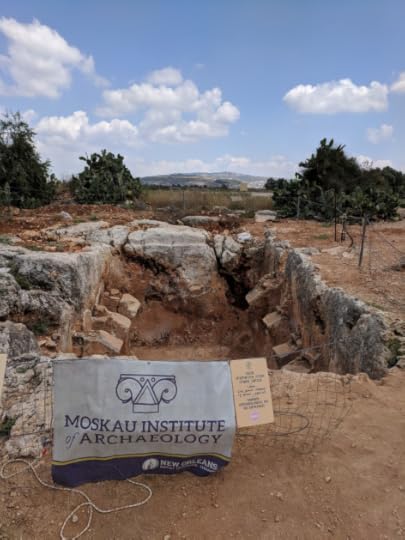 The dig is a project of Moskau Institute of ArchaeologyFor the work in the bowl like hole in the floor I used a trowel to lift dirt, inspect its contents and put it in a bucket for removal. Some of the fill dirt in this project was rich in pottery, which, when found, we placed in a special pottery bucket.
The dig is a project of Moskau Institute of ArchaeologyFor the work in the bowl like hole in the floor I used a trowel to lift dirt, inspect its contents and put it in a bucket for removal. Some of the fill dirt in this project was rich in pottery, which, when found, we placed in a special pottery bucket.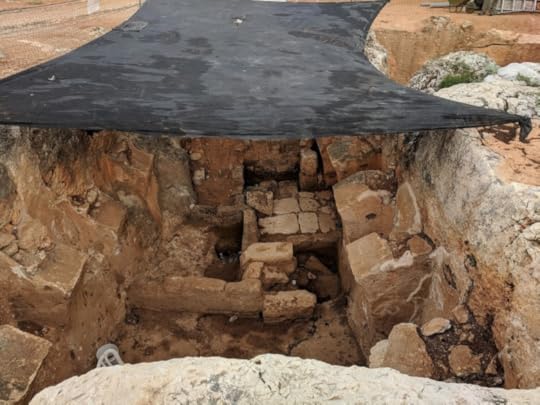 The room under the tarpWhen the bowl was cleaned, was moved into a room on the northern side of the central area of the cistern. This small room (perhaps 6’ x 6’) was one of the areas of major focus for our dig. I worked my way down through the dirt between large rocks which had collected into the square.
The room under the tarpWhen the bowl was cleaned, was moved into a room on the northern side of the central area of the cistern. This small room (perhaps 6’ x 6’) was one of the areas of major focus for our dig. I worked my way down through the dirt between large rocks which had collected into the square.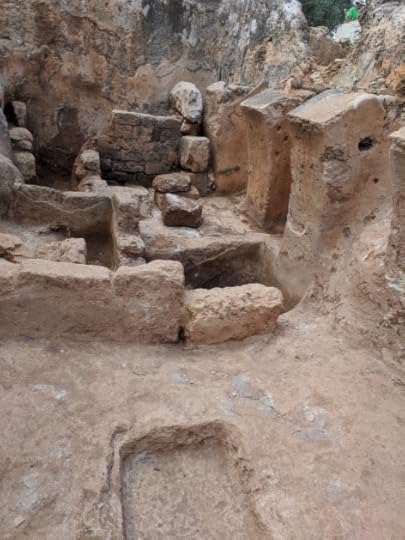 A picture taken to the west in the cisternLate in the morning Dr. Tsvika Tsuk, chief archaeologist at the Israel Nature and Parks Authority looked at the room and identified the large rocks as blocks of the arches which had fallen. The roof structure was held up by Roman arches with stone crossmembers. These collapsed at some time during the cistern’s 2,000 year history.
A picture taken to the west in the cisternLate in the morning Dr. Tsvika Tsuk, chief archaeologist at the Israel Nature and Parks Authority looked at the room and identified the large rocks as blocks of the arches which had fallen. The roof structure was held up by Roman arches with stone crossmembers. These collapsed at some time during the cistern’s 2,000 year history.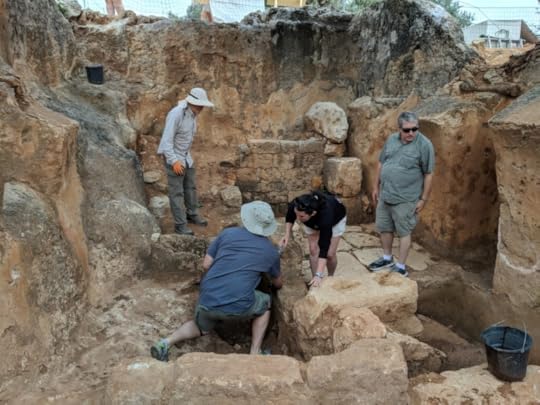 Removing large rocks in the CisternThe large blocks used for arch construction were salvaged and moved into the southern room of the cistern. They will be numbered and removed at a later date by crane. The other rock in the hole was demolished so it could be put into buckets and lifted to a ground level area designated for rock removal.
Removing large rocks in the CisternThe large blocks used for arch construction were salvaged and moved into the southern room of the cistern. They will be numbered and removed at a later date by crane. The other rock in the hole was demolished so it could be put into buckets and lifted to a ground level area designated for rock removal.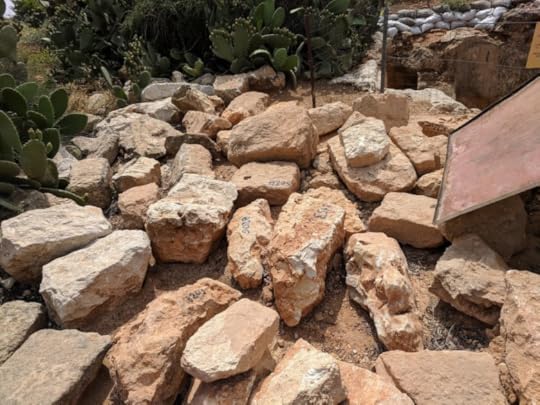 Rocks labeled for reconstruction of the ArchesWhen the rocks were removed (and when subsequent rocks were removed), each of the diggers in turn removed more dirt from the room. Eventually we went down four or five feet below the beginning surface and revealed two steps into the room.
Rocks labeled for reconstruction of the ArchesWhen the rocks were removed (and when subsequent rocks were removed), each of the diggers in turn removed more dirt from the room. Eventually we went down four or five feet below the beginning surface and revealed two steps into the room.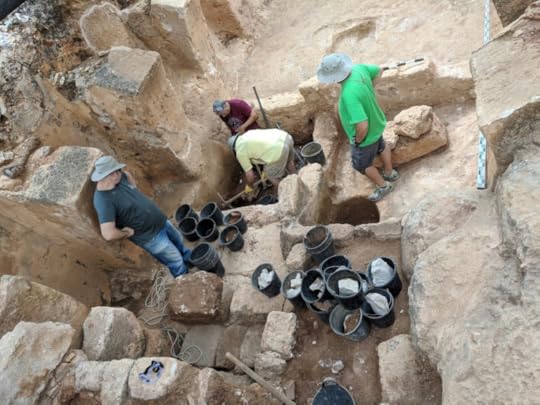 The dig in progressWe also worked on dirt removal in an area on the western end of the cistern. The dirt was sandwiched between a newer wall and the original southern end of the water reservoirs. Six to eight feet of dirt was removed from this area, and we found (after three days of digging) the original cistern floor.
The dig in progressWe also worked on dirt removal in an area on the western end of the cistern. The dirt was sandwiched between a newer wall and the original southern end of the water reservoirs. Six to eight feet of dirt was removed from this area, and we found (after three days of digging) the original cistern floor.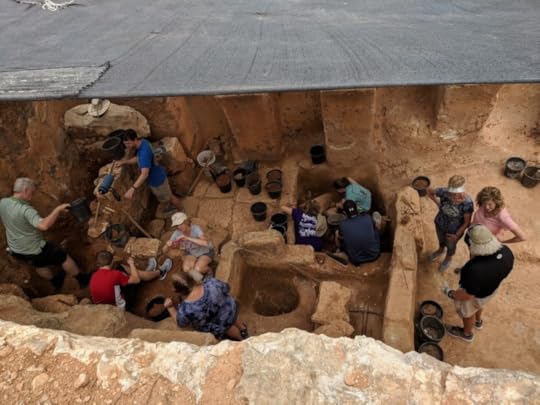 A group visiting from Atlanta, GADuring one afternoon at the dig, a tour group (known to our leaders) came and participated in the dig. All enjoyed the activities and the finds.
A group visiting from Atlanta, GADuring one afternoon at the dig, a tour group (known to our leaders) came and participated in the dig. All enjoyed the activities and the finds.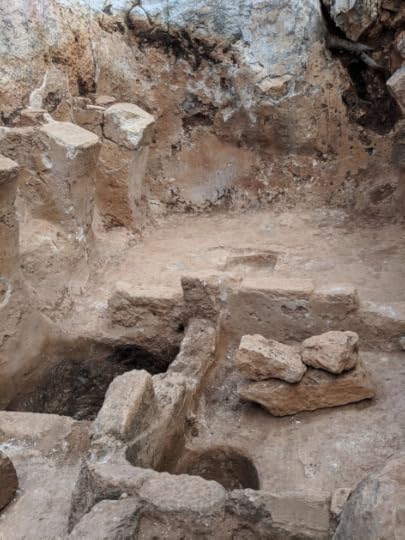 Close-up of central rooms in the CisternPicks (called a mattock) and digging hoe were used to loosen large amounts of dirt and to scoop it into the little black buckets. As the work progressed, I became part of a chain which lifted dirt out of the hole. After the dirt reached the surface area it was placed in a wheelbarrow, and dumped into areas designated for each part of the dig. During the last two days of the dig I was the designated carter and dumper.
Close-up of central rooms in the CisternPicks (called a mattock) and digging hoe were used to loosen large amounts of dirt and to scoop it into the little black buckets. As the work progressed, I became part of a chain which lifted dirt out of the hole. After the dirt reached the surface area it was placed in a wheelbarrow, and dumped into areas designated for each part of the dig. During the last two days of the dig I was the designated carter and dumper.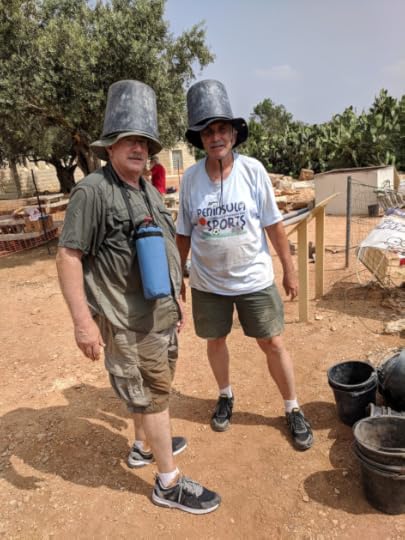 A new use for black archaeological bucketsAfter the dirt was dumped, one of the archaeologists would come to each pile of dirt and examine it for metal. He discovered lots of nails and a few coins.
A new use for black archaeological bucketsAfter the dirt was dumped, one of the archaeologists would come to each pile of dirt and examine it for metal. He discovered lots of nails and a few coins.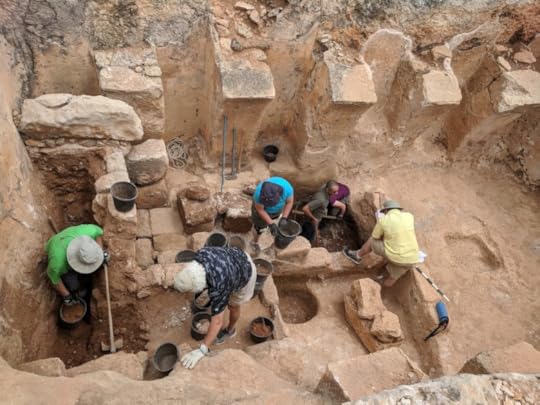 Workers near the end of the projectWe also found Roman glass, roofing tiles, a mosaic block, and plaster.
Workers near the end of the projectWe also found Roman glass, roofing tiles, a mosaic block, and plaster.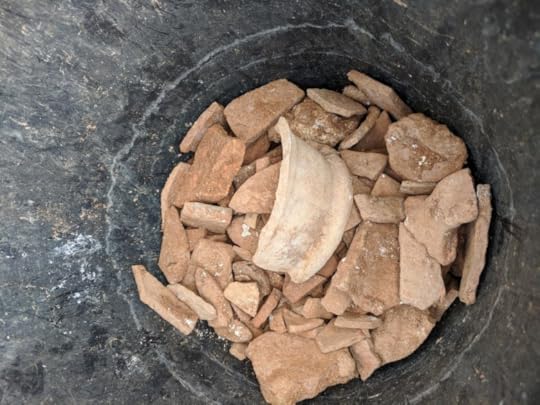 Bucket of recovered potteryEach day the archaeologists would speak about findings. They continued to think about what was found after they went home, and shared developed ideas each morning.
Bucket of recovered potteryEach day the archaeologists would speak about findings. They continued to think about what was found after they went home, and shared developed ideas each morning.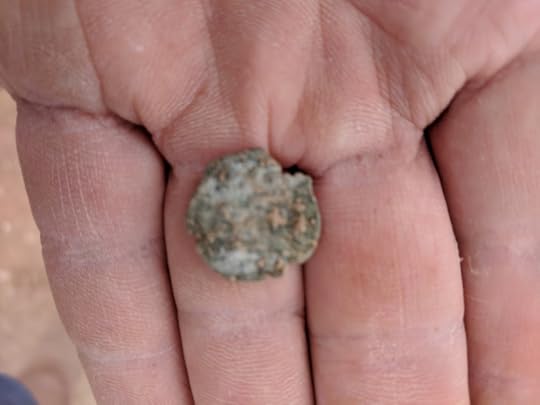 Coin from the Arab periodThere were two layers of plaster in the cistern. The first was grey and the second was pink. Some of the stones were placed in front of the first century grey plaster for a later use. The new wall of rocks at the southern end of the cistern had no plaster.
Coin from the Arab periodThere were two layers of plaster in the cistern. The first was grey and the second was pink. Some of the stones were placed in front of the first century grey plaster for a later use. The new wall of rocks at the southern end of the cistern had no plaster.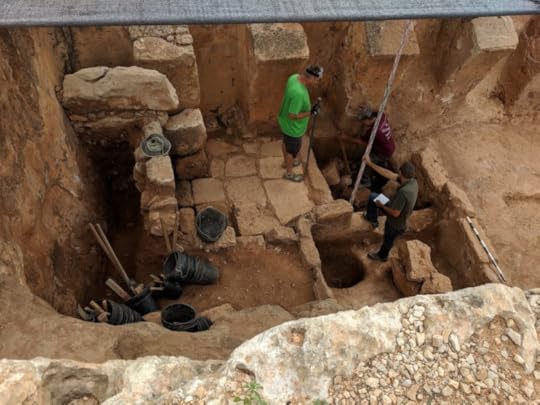 Measuring the depth of the holeThe concept that emerged was that the Arches Reservoir had three uses. The first was to hold water (first century). After new cisterns were developed for a growing population, the cistern developed into a wine press. Grapes were stomped in the square box in the floor on the eastern room of the cistern.
Measuring the depth of the holeThe concept that emerged was that the Arches Reservoir had three uses. The first was to hold water (first century). After new cisterns were developed for a growing population, the cistern developed into a wine press. Grapes were stomped in the square box in the floor on the eastern room of the cistern.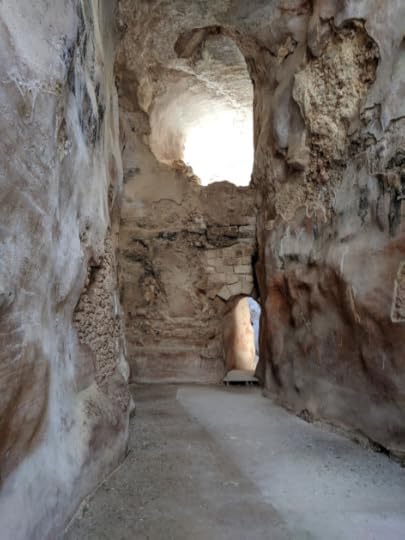 The "new" second century cisternA drain was found leading into the square box into the central room (northern side with two steps) that drained and retained the grape juice.
The "new" second century cisternA drain was found leading into the square box into the central room (northern side with two steps) that drained and retained the grape juice.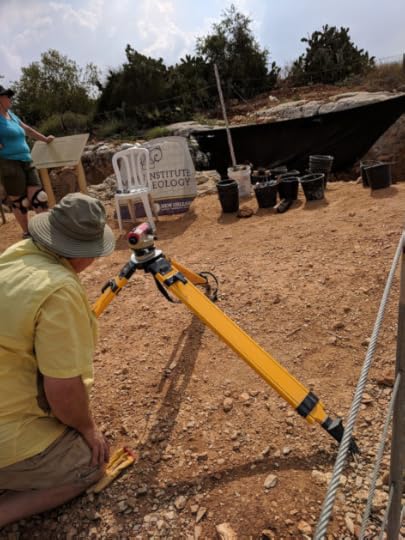 Surveying the digIn the fifth century (dated by coins we found) stairs were built down the western wall of the cistern. The underground room became a prison, house or was used for some other purpose. Tiles were placed on top of the cistern plaster in the western room by the stairs.
Surveying the digIn the fifth century (dated by coins we found) stairs were built down the western wall of the cistern. The underground room became a prison, house or was used for some other purpose. Tiles were placed on top of the cistern plaster in the western room by the stairs.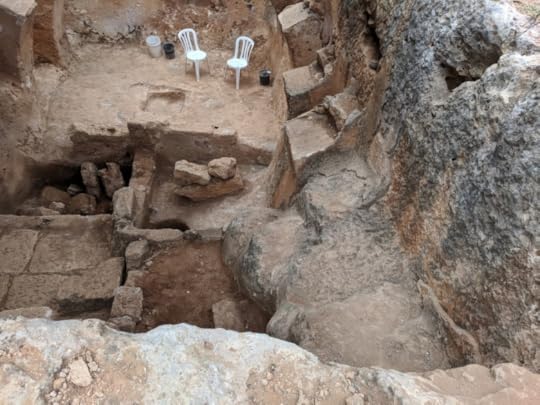 A final picture of our dig at TsipporiAt the end of the project surveyors came to document everything, a coin specialist visited, the pottery was washed, and the Arches Reservoirs were photographed.
A final picture of our dig at TsipporiAt the end of the project surveyors came to document everything, a coin specialist visited, the pottery was washed, and the Arches Reservoirs were photographed.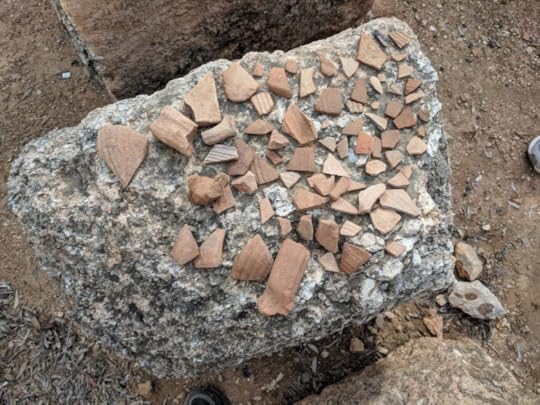 Washed Pottery
Washed Pottery
All of the findings will be studied and documented. Eventually a report will be written and shared so other archeologists can understand and use the findings.
 The Water Project at Tel GezerThe first was at Tel Gezer, where I was asked to clean the steps leading down into what is known as the water project.
The Water Project at Tel GezerThe first was at Tel Gezer, where I was asked to clean the steps leading down into what is known as the water project. Cleaning the steps going into the earthThe steps, which are over 4,000 years old are made of soft limestone, and chip easily. The work involved careful brushing or lifting dirt with a mini mattock to remove all but surface level dirt, or to reveal the limestone step.
Cleaning the steps going into the earthThe steps, which are over 4,000 years old are made of soft limestone, and chip easily. The work involved careful brushing or lifting dirt with a mini mattock to remove all but surface level dirt, or to reveal the limestone step. Looking up the steps into the cityThe second project was at the first century Arches Reservoir at Sippori.
Looking up the steps into the cityThe second project was at the first century Arches Reservoir at Sippori. Information about Arches ReservoirsOur project at Tsippori began with trash removal and then sweeping surface areas which had been recently excavated in order to obtain archaeological photographs.
Information about Arches ReservoirsOur project at Tsippori began with trash removal and then sweeping surface areas which had been recently excavated in order to obtain archaeological photographs.  Looking into the Cistern when we arrivedThese pictures were taken in the early morning to lessen shadows created when the sun is high in the sky.
Looking into the Cistern when we arrivedThese pictures were taken in the early morning to lessen shadows created when the sun is high in the sky. Archaeological PhotographyAfter the pictures were taken, a tarp was spread and tied over the Arches Reservoir to provide shade as we worked.
Archaeological PhotographyAfter the pictures were taken, a tarp was spread and tied over the Arches Reservoir to provide shade as we worked. Spreading a tarp for the workersI was asked to remove dirt from a basin in the southern room of the central section of the former cistern (tank which was built for holding the community’s water).
Spreading a tarp for the workersI was asked to remove dirt from a basin in the southern room of the central section of the former cistern (tank which was built for holding the community’s water). Two Cisterns, our dig is to the leftIt is thought that water was brought through channels (or aqueducts) from springs along the ridge of the Nazareth Mountains. When the Arches Reservoirs were first built in the days of Herod Archelaus, the cisterns were filled with water for the population of Sipporus.
Two Cisterns, our dig is to the leftIt is thought that water was brought through channels (or aqueducts) from springs along the ridge of the Nazareth Mountains. When the Arches Reservoirs were first built in the days of Herod Archelaus, the cisterns were filled with water for the population of Sipporus. The dig is a project of Moskau Institute of ArchaeologyFor the work in the bowl like hole in the floor I used a trowel to lift dirt, inspect its contents and put it in a bucket for removal. Some of the fill dirt in this project was rich in pottery, which, when found, we placed in a special pottery bucket.
The dig is a project of Moskau Institute of ArchaeologyFor the work in the bowl like hole in the floor I used a trowel to lift dirt, inspect its contents and put it in a bucket for removal. Some of the fill dirt in this project was rich in pottery, which, when found, we placed in a special pottery bucket. The room under the tarpWhen the bowl was cleaned, was moved into a room on the northern side of the central area of the cistern. This small room (perhaps 6’ x 6’) was one of the areas of major focus for our dig. I worked my way down through the dirt between large rocks which had collected into the square.
The room under the tarpWhen the bowl was cleaned, was moved into a room on the northern side of the central area of the cistern. This small room (perhaps 6’ x 6’) was one of the areas of major focus for our dig. I worked my way down through the dirt between large rocks which had collected into the square. A picture taken to the west in the cisternLate in the morning Dr. Tsvika Tsuk, chief archaeologist at the Israel Nature and Parks Authority looked at the room and identified the large rocks as blocks of the arches which had fallen. The roof structure was held up by Roman arches with stone crossmembers. These collapsed at some time during the cistern’s 2,000 year history.
A picture taken to the west in the cisternLate in the morning Dr. Tsvika Tsuk, chief archaeologist at the Israel Nature and Parks Authority looked at the room and identified the large rocks as blocks of the arches which had fallen. The roof structure was held up by Roman arches with stone crossmembers. These collapsed at some time during the cistern’s 2,000 year history. Removing large rocks in the CisternThe large blocks used for arch construction were salvaged and moved into the southern room of the cistern. They will be numbered and removed at a later date by crane. The other rock in the hole was demolished so it could be put into buckets and lifted to a ground level area designated for rock removal.
Removing large rocks in the CisternThe large blocks used for arch construction were salvaged and moved into the southern room of the cistern. They will be numbered and removed at a later date by crane. The other rock in the hole was demolished so it could be put into buckets and lifted to a ground level area designated for rock removal. Rocks labeled for reconstruction of the ArchesWhen the rocks were removed (and when subsequent rocks were removed), each of the diggers in turn removed more dirt from the room. Eventually we went down four or five feet below the beginning surface and revealed two steps into the room.
Rocks labeled for reconstruction of the ArchesWhen the rocks were removed (and when subsequent rocks were removed), each of the diggers in turn removed more dirt from the room. Eventually we went down four or five feet below the beginning surface and revealed two steps into the room. The dig in progressWe also worked on dirt removal in an area on the western end of the cistern. The dirt was sandwiched between a newer wall and the original southern end of the water reservoirs. Six to eight feet of dirt was removed from this area, and we found (after three days of digging) the original cistern floor.
The dig in progressWe also worked on dirt removal in an area on the western end of the cistern. The dirt was sandwiched between a newer wall and the original southern end of the water reservoirs. Six to eight feet of dirt was removed from this area, and we found (after three days of digging) the original cistern floor. A group visiting from Atlanta, GADuring one afternoon at the dig, a tour group (known to our leaders) came and participated in the dig. All enjoyed the activities and the finds.
A group visiting from Atlanta, GADuring one afternoon at the dig, a tour group (known to our leaders) came and participated in the dig. All enjoyed the activities and the finds. Close-up of central rooms in the CisternPicks (called a mattock) and digging hoe were used to loosen large amounts of dirt and to scoop it into the little black buckets. As the work progressed, I became part of a chain which lifted dirt out of the hole. After the dirt reached the surface area it was placed in a wheelbarrow, and dumped into areas designated for each part of the dig. During the last two days of the dig I was the designated carter and dumper.
Close-up of central rooms in the CisternPicks (called a mattock) and digging hoe were used to loosen large amounts of dirt and to scoop it into the little black buckets. As the work progressed, I became part of a chain which lifted dirt out of the hole. After the dirt reached the surface area it was placed in a wheelbarrow, and dumped into areas designated for each part of the dig. During the last two days of the dig I was the designated carter and dumper. A new use for black archaeological bucketsAfter the dirt was dumped, one of the archaeologists would come to each pile of dirt and examine it for metal. He discovered lots of nails and a few coins.
A new use for black archaeological bucketsAfter the dirt was dumped, one of the archaeologists would come to each pile of dirt and examine it for metal. He discovered lots of nails and a few coins. Workers near the end of the projectWe also found Roman glass, roofing tiles, a mosaic block, and plaster.
Workers near the end of the projectWe also found Roman glass, roofing tiles, a mosaic block, and plaster. Bucket of recovered potteryEach day the archaeologists would speak about findings. They continued to think about what was found after they went home, and shared developed ideas each morning.
Bucket of recovered potteryEach day the archaeologists would speak about findings. They continued to think about what was found after they went home, and shared developed ideas each morning. Coin from the Arab periodThere were two layers of plaster in the cistern. The first was grey and the second was pink. Some of the stones were placed in front of the first century grey plaster for a later use. The new wall of rocks at the southern end of the cistern had no plaster.
Coin from the Arab periodThere were two layers of plaster in the cistern. The first was grey and the second was pink. Some of the stones were placed in front of the first century grey plaster for a later use. The new wall of rocks at the southern end of the cistern had no plaster. Measuring the depth of the holeThe concept that emerged was that the Arches Reservoir had three uses. The first was to hold water (first century). After new cisterns were developed for a growing population, the cistern developed into a wine press. Grapes were stomped in the square box in the floor on the eastern room of the cistern.
Measuring the depth of the holeThe concept that emerged was that the Arches Reservoir had three uses. The first was to hold water (first century). After new cisterns were developed for a growing population, the cistern developed into a wine press. Grapes were stomped in the square box in the floor on the eastern room of the cistern. The "new" second century cisternA drain was found leading into the square box into the central room (northern side with two steps) that drained and retained the grape juice.
The "new" second century cisternA drain was found leading into the square box into the central room (northern side with two steps) that drained and retained the grape juice. Surveying the digIn the fifth century (dated by coins we found) stairs were built down the western wall of the cistern. The underground room became a prison, house or was used for some other purpose. Tiles were placed on top of the cistern plaster in the western room by the stairs.
Surveying the digIn the fifth century (dated by coins we found) stairs were built down the western wall of the cistern. The underground room became a prison, house or was used for some other purpose. Tiles were placed on top of the cistern plaster in the western room by the stairs. A final picture of our dig at TsipporiAt the end of the project surveyors came to document everything, a coin specialist visited, the pottery was washed, and the Arches Reservoirs were photographed.
A final picture of our dig at TsipporiAt the end of the project surveyors came to document everything, a coin specialist visited, the pottery was washed, and the Arches Reservoirs were photographed. Washed Pottery
Washed PotteryAll of the findings will be studied and documented. Eventually a report will be written and shared so other archeologists can understand and use the findings.
Published on June 01, 2018 07:39
May 30, 2018
Digging in Zippori
Yesterday, today and tomorrow’s activity involved investigating a first century water system. We are concluding a dig on a cistern in order to determine the flow of water.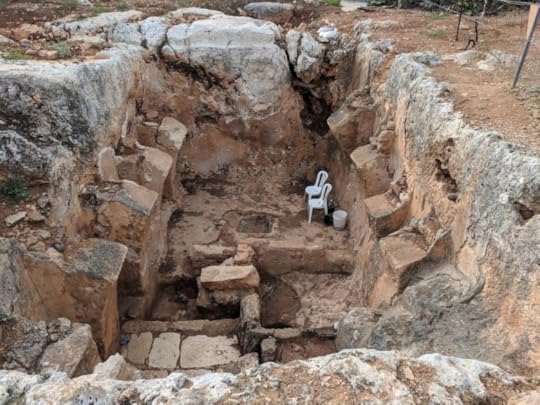 Cistern Archaeology Project at BeginningThe town of Tsippori originated in the fourth century BC (or maybe before) on a high hilltop which offered both protection and a great view. The name Tsippori means “Bird,” perhaps, as the Talmud suggests, because it was "perched on the top of a mountain, like a bird.” (Megillah, 6, 81)
Cistern Archaeology Project at BeginningThe town of Tsippori originated in the fourth century BC (or maybe before) on a high hilltop which offered both protection and a great view. The name Tsippori means “Bird,” perhaps, as the Talmud suggests, because it was "perched on the top of a mountain, like a bird.” (Megillah, 6, 81)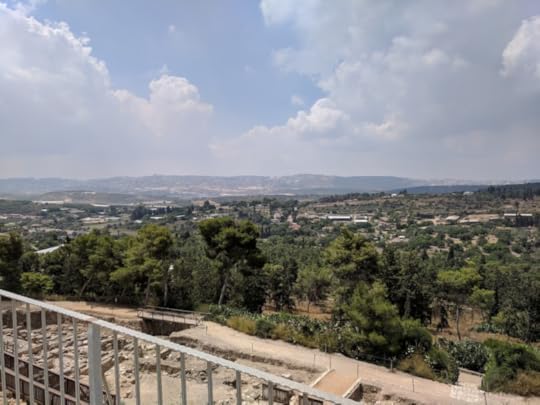 Looking across Galilee, as a BirdThe city was very strong, and for this reason it became a regional capital. According to Josephus, Tsippori was called the "glory of the entire Galilee."
Looking across Galilee, as a BirdThe city was very strong, and for this reason it became a regional capital. According to Josephus, Tsippori was called the "glory of the entire Galilee."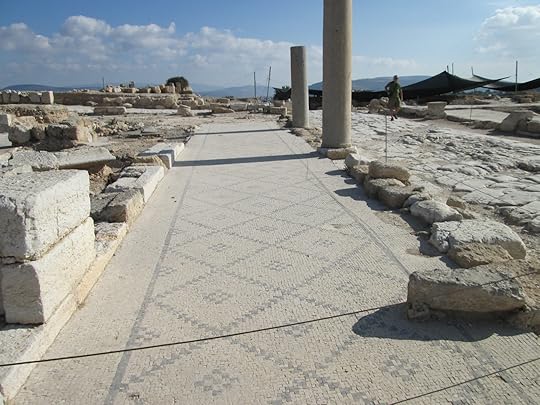 Mosaic walkways in the market in ZipporiWhen Herod's son, Herod Antipas was made tetrarch, he made Sippori the capital of all of Galilee, and began a huge building project.
Mosaic walkways in the market in ZipporiWhen Herod's son, Herod Antipas was made tetrarch, he made Sippori the capital of all of Galilee, and began a huge building project.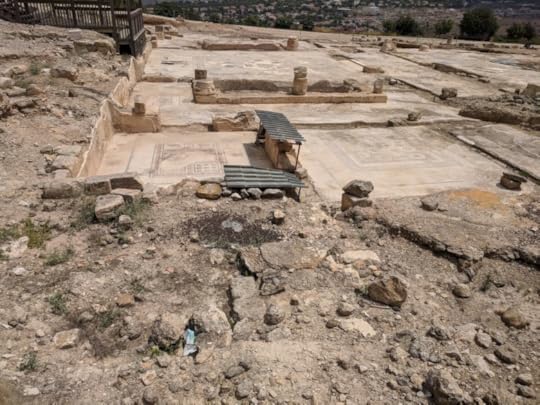 Mosaic floors from homes in SepphorisIt might have been at this time the cistern where we are working was created as a resigour along the aqueduct from water sources around the Nazareth Mountains.
Mosaic floors from homes in SepphorisIt might have been at this time the cistern where we are working was created as a resigour along the aqueduct from water sources around the Nazareth Mountains.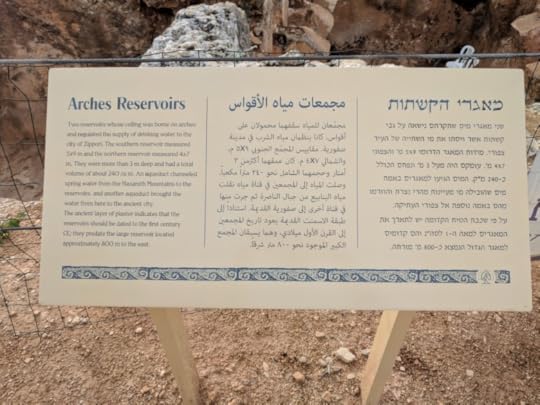 Information sign for the CisternThe population was mixed, but mostly gentiles.
Information sign for the CisternThe population was mixed, but mostly gentiles.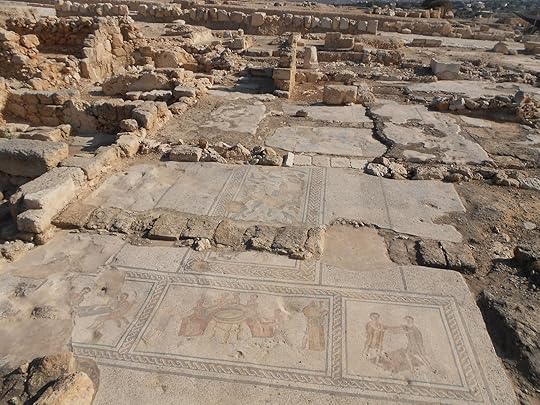 Mosaics from homes in TsipporiThe city is laid out in a typical Roman pattern with wide north-south and east-west cardios. There is a large shopping complex where the main roads cross.
Mosaics from homes in TsipporiThe city is laid out in a typical Roman pattern with wide north-south and east-west cardios. There is a large shopping complex where the main roads cross.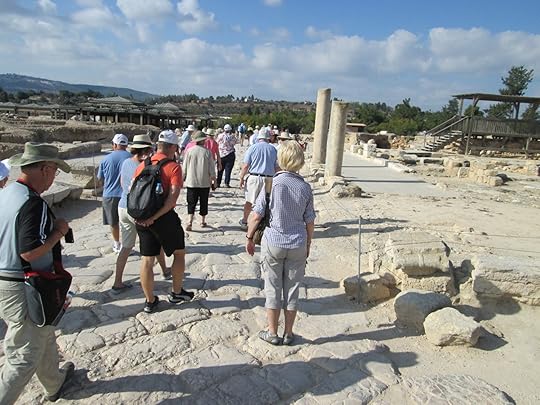 Walking on the old Roman CardioThe homes in Sepphoris were quite ornate and featured mosaic floors.
Walking on the old Roman CardioThe homes in Sepphoris were quite ornate and featured mosaic floors.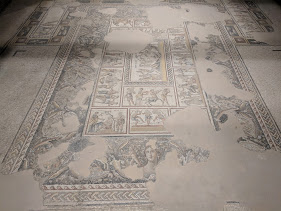 Mosaic Mona Lisa of the GalileeA small Jewish area is located near the top of the hill,
Mosaic Mona Lisa of the GalileeA small Jewish area is located near the top of the hill,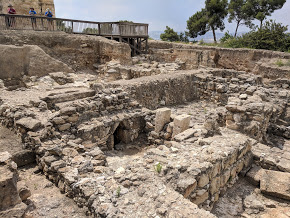 Jewish Neighborhood in ZipporiIt features mikvah pools, which tell of its Jewish character.
Jewish Neighborhood in ZipporiIt features mikvah pools, which tell of its Jewish character.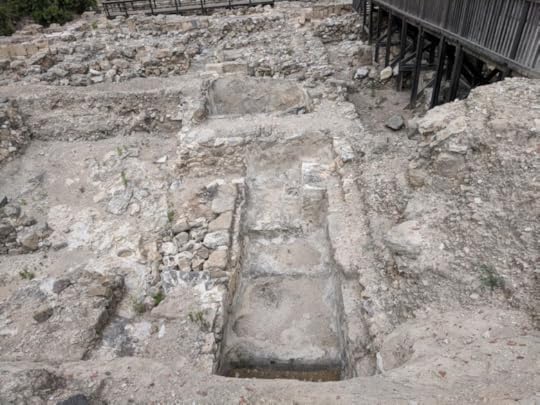 Looking at a Mikvah PoolThe Sanhedrin met here for a time after the destruction of the Temple.
Looking at a Mikvah PoolThe Sanhedrin met here for a time after the destruction of the Temple.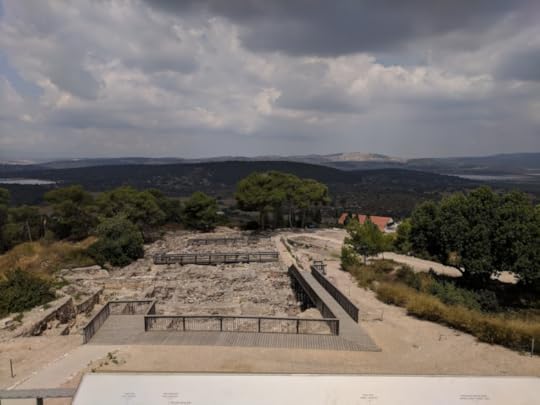 Bird's Eye View of Jewish Neighborhood, Mount Carmel in backgroundRabbi Yehuda Hanassi transferred the seat of the Sanhedrin from Bet She'arim to Tsippori, and around 220 CE he completed the Mishna in the city.
Bird's Eye View of Jewish Neighborhood, Mount Carmel in backgroundRabbi Yehuda Hanassi transferred the seat of the Sanhedrin from Bet She'arim to Tsippori, and around 220 CE he completed the Mishna in the city. 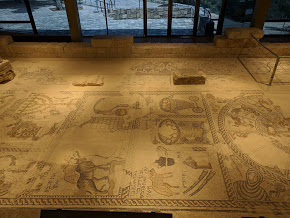 Synagogue MosaicThe Synagogue of the city saw several renovations over the years. The mosaic floor of the fifth century Synagogue is enclosed with a multimedia presentation. It contains scenes from Bible stories, priestly offerings and a zodiac diagram.
Synagogue MosaicThe Synagogue of the city saw several renovations over the years. The mosaic floor of the fifth century Synagogue is enclosed with a multimedia presentation. It contains scenes from Bible stories, priestly offerings and a zodiac diagram.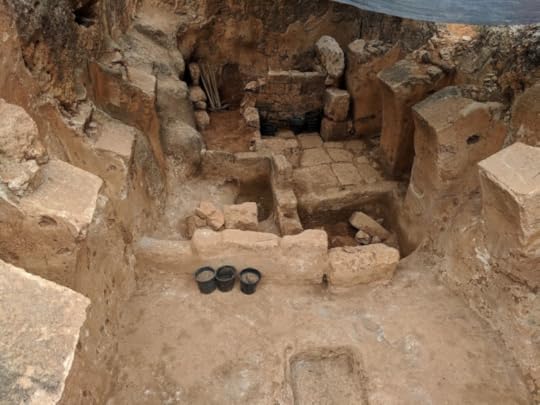 Cistern Project this evening, compare for progressOur work on the water cistern has made huge strides in the past few days.
Cistern Project this evening, compare for progressOur work on the water cistern has made huge strides in the past few days.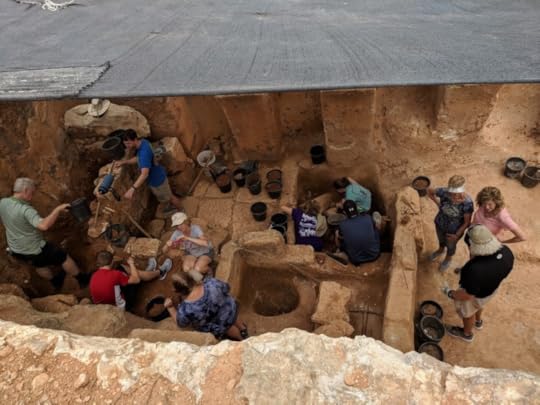 Tour Group from Georgia that helped us digWe have found pottery, old nails, roof tiles, some Roman glass, and old coins.
Tour Group from Georgia that helped us digWe have found pottery, old nails, roof tiles, some Roman glass, and old coins.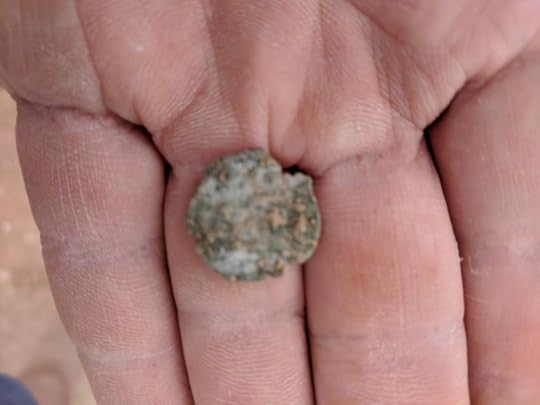 One of the coins found at Tsippori
One of the coins found at Tsippori
The archaeological dig was productive and enjoyable.
 Cistern Archaeology Project at BeginningThe town of Tsippori originated in the fourth century BC (or maybe before) on a high hilltop which offered both protection and a great view. The name Tsippori means “Bird,” perhaps, as the Talmud suggests, because it was "perched on the top of a mountain, like a bird.” (Megillah, 6, 81)
Cistern Archaeology Project at BeginningThe town of Tsippori originated in the fourth century BC (or maybe before) on a high hilltop which offered both protection and a great view. The name Tsippori means “Bird,” perhaps, as the Talmud suggests, because it was "perched on the top of a mountain, like a bird.” (Megillah, 6, 81) Looking across Galilee, as a BirdThe city was very strong, and for this reason it became a regional capital. According to Josephus, Tsippori was called the "glory of the entire Galilee."
Looking across Galilee, as a BirdThe city was very strong, and for this reason it became a regional capital. According to Josephus, Tsippori was called the "glory of the entire Galilee." Mosaic walkways in the market in ZipporiWhen Herod's son, Herod Antipas was made tetrarch, he made Sippori the capital of all of Galilee, and began a huge building project.
Mosaic walkways in the market in ZipporiWhen Herod's son, Herod Antipas was made tetrarch, he made Sippori the capital of all of Galilee, and began a huge building project. Mosaic floors from homes in SepphorisIt might have been at this time the cistern where we are working was created as a resigour along the aqueduct from water sources around the Nazareth Mountains.
Mosaic floors from homes in SepphorisIt might have been at this time the cistern where we are working was created as a resigour along the aqueduct from water sources around the Nazareth Mountains. Information sign for the CisternThe population was mixed, but mostly gentiles.
Information sign for the CisternThe population was mixed, but mostly gentiles. Mosaics from homes in TsipporiThe city is laid out in a typical Roman pattern with wide north-south and east-west cardios. There is a large shopping complex where the main roads cross.
Mosaics from homes in TsipporiThe city is laid out in a typical Roman pattern with wide north-south and east-west cardios. There is a large shopping complex where the main roads cross. Walking on the old Roman CardioThe homes in Sepphoris were quite ornate and featured mosaic floors.
Walking on the old Roman CardioThe homes in Sepphoris were quite ornate and featured mosaic floors. Mosaic Mona Lisa of the GalileeA small Jewish area is located near the top of the hill,
Mosaic Mona Lisa of the GalileeA small Jewish area is located near the top of the hill, Jewish Neighborhood in ZipporiIt features mikvah pools, which tell of its Jewish character.
Jewish Neighborhood in ZipporiIt features mikvah pools, which tell of its Jewish character. Looking at a Mikvah PoolThe Sanhedrin met here for a time after the destruction of the Temple.
Looking at a Mikvah PoolThe Sanhedrin met here for a time after the destruction of the Temple. Bird's Eye View of Jewish Neighborhood, Mount Carmel in backgroundRabbi Yehuda Hanassi transferred the seat of the Sanhedrin from Bet She'arim to Tsippori, and around 220 CE he completed the Mishna in the city.
Bird's Eye View of Jewish Neighborhood, Mount Carmel in backgroundRabbi Yehuda Hanassi transferred the seat of the Sanhedrin from Bet She'arim to Tsippori, and around 220 CE he completed the Mishna in the city.  Synagogue MosaicThe Synagogue of the city saw several renovations over the years. The mosaic floor of the fifth century Synagogue is enclosed with a multimedia presentation. It contains scenes from Bible stories, priestly offerings and a zodiac diagram.
Synagogue MosaicThe Synagogue of the city saw several renovations over the years. The mosaic floor of the fifth century Synagogue is enclosed with a multimedia presentation. It contains scenes from Bible stories, priestly offerings and a zodiac diagram. Cistern Project this evening, compare for progressOur work on the water cistern has made huge strides in the past few days.
Cistern Project this evening, compare for progressOur work on the water cistern has made huge strides in the past few days. Tour Group from Georgia that helped us digWe have found pottery, old nails, roof tiles, some Roman glass, and old coins.
Tour Group from Georgia that helped us digWe have found pottery, old nails, roof tiles, some Roman glass, and old coins. One of the coins found at Tsippori
One of the coins found at TsipporiThe archaeological dig was productive and enjoyable.
Published on May 30, 2018 11:16



